

August 2023
|
Search the FOA website
FOA Home Page
Contact
Us
|
Sign
up for the FOA eMail Newsletter
Privacy Policy
Sections
News
Technical
Worth
Reading Q&A
Training/FiberU
Resoures
Safety
About
|
What's Weather Got To Do With Fiber Optics?
Safety While Working In Extreme Heat
Rural Networks Vulnerable To Wildfires
Wildfires And Aerial Cables
Preparation For Disaster Recovery
Good Lessons For Restoration
Newsletter Sections
Click
on any link to jump to that section
News
Recognized as a Telecom Tech
How Many Satellites Do You Need?
Comm College Grads Earn More
ISE Expo 2023
Global Excavation Safety Conference 2024
FiberWizards Online Programs
Technical
Bad FTTH Residential Cable Installation
What's Inside - 864 Fiber Cable
Reading The Cable Jacket
New Tool FOr Wet-Dry Cleaning
Microtrenching More Vulnerable To Cuts?
NATE Video On Work Zone Protection
Managing Projects - Gantt Charts
FOA Color Code Guides
FOA Online Loss Budget Calculator
Worth
Reading Lots of interesting
articles
Q&A
Questions from our readers
Always Interesting!
Training/FiberU
New FOA-Approved Schools,
Fiber U
MiniCourses
more
Resources
New FOA Technical Resources
Safety
About the FOA
FOA Certified Techs:
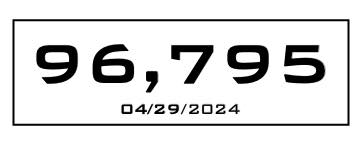
Time
To Renew Your FOA Certifications?
Special offer - 1/3
Off Renewal
Jobs
- See FOA Jobs
Web Page and FOA on

- The FOA Jobs
Web Page has been updated and a new page added
on Using your FOA
Training/Certification to Find the Right Job
in Fiber Optics
Where
Are The Jobs In Fiber Optics? FOA talks about
all the applications for fiber optics, what jobs
involve and the qualifications for the workers in
the field in this YouTube video.
Join The FOA eMail Newsletter
List
Want
to be notified when the FOA Newsletter is updated? Sign
up for the FOA eMail Newsletter. You can
also sign up from your cell phone: text "FOA" to
22828 (usual text message charges apply)
Trademarks:
The FOA CFOT® (Certified Fiber Optic Technician) and
Fiber U® (the FOA online learning site) are
registered trademarks of the FOA.

Want to know more about fiber optics?
Looking for specific information? Here's the largest
technical reference on the web: The
FOA Online Fiber Optic Reference Guide.
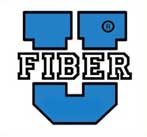
Free online self-study programs
on many fiber optics and cabling topics are
available at Fiber U,
FOA's online web-based training website.
FOA
Reference Books
Available Printed or eBooks
The fiber book is
available in Spanish and French
  
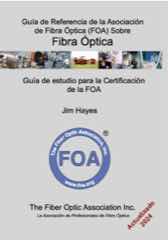
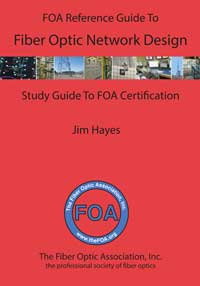 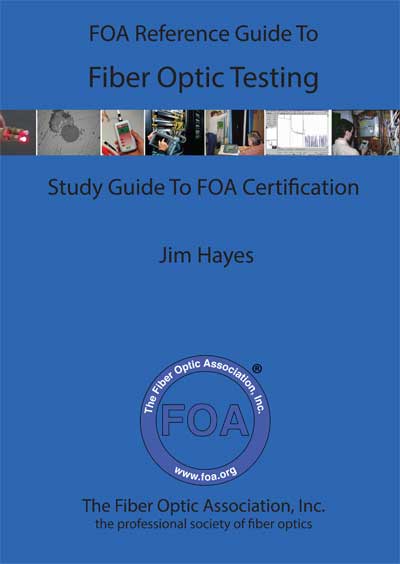
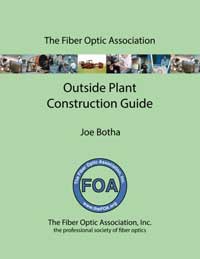 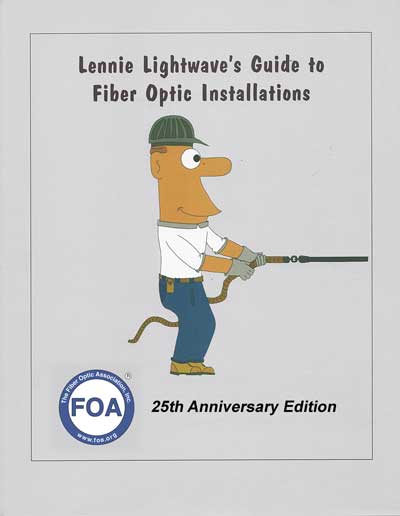
Lennie
and Uncle Ted's
Guides are now also available as free iBooks on
iTunes.
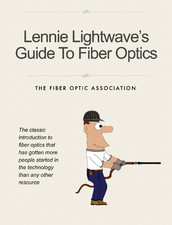
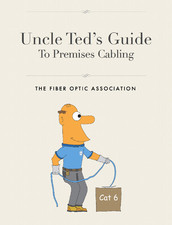
Click on any of
the books to learn more.
- Fiber
Optic Safety Poster to download and
print
FOA Videos on 
FOA
is a member of:




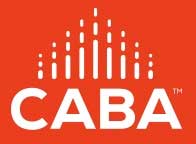
The FOA Newsletter is
edited by Jim Hayes - send your stories, leads,
ideas, comments to <jim @ foa.org>

Search the FOA Website With
DuckDuckGo
Top Stories From The Past FOA Newsletters
- The Archives: Past
Issues.
- Use these links to
read past issues or use FOA's
Custom Search to look for specific
topics on our website.
1/23, 2/23, 3/23, 4/23, 5/23, 6/23, 7/23, 8/23,
1/22, 2/22, 3/22, 4/22, 5/22, 6/22, 7/22, 8/22, 9/22, 10/22, 11/22, 12/22
1/21, 2/21. 3/21, 4/21, 5/21, 6/21, 7/21, 8/21, 9/21, 10/21,
11-12/21,
1/20,
2/20,
3/20.
4/20,
5/20,
6/20,
7/20,
8/20,
9/20,
10/20,
11/20,
12/20,
1/19,
2/19,
3/19,
4/19, 5/19, 6/19, 7/19, 8/19, 9/19,
10/19,
11/19,
12/19
1/18,
2/18,
3/18, 4/18,
5/18, 6/18, 7/18, 8/18, 9/18, 10/18,
12/18.
1/17, 2/17, 3/17, 4/17, 5/17, 6/17,
7/17,
8/17,
9/17,
10/17, 11/17,
12/17
1/16, 2/16, 3/16,
4/16,
5/16,
6/16,
7-8/16,
9/16,
10/16,
11/16,
12/16
1/15,
2/15,
3/15,
4/15,
5/15,
6/15,
7/15,
8/15,
9/15 ,
10/15,
11/15
, 12/15
1/14,
2/14,
3/14,
4/14,
5/14,
6/14,
7/14,
8/14,
9/14,
10/14,
11/14,
12/14
1/13,
2/13,
3/13,
4/13,
5/13, 6/13,
7/13,
8/13,
9/13,
10/13,
11/13,
12/13
1/12
, 2/12,
3/12,
4/12,
6/12,
7/12,
8/12,
9/12,
10/12,
11/12,
12/12
1/11 ,
2/11,
3/11,
4/11,
6/11,
7/11,
8/11,
9/11, 10/11,
11/11,
12/11,
1/10 ,
2/10,
3/10,
4/10,
05/10,
07/10,
08/10,
09/10,
10/10,
11/10
1/09 ,
2/09,
3/09,
04/09,
05/09,
07/09,
08/09,
09/09,
10/09, 11/09,
12/09
1/08 , 2/08, 3/08, 4/08, 5/08, 6/08, 7/08, 8/08, 09/08, 10/08, 11/08, 12/08
12/07 , 11/07, 10/07, 09/07, 08/07, 07/07, 06/07, 05/07, 04/07, 03/07, 2/07, 1/07
12/06 , 11/06, 10/06, 09/06, 8/06, 7/06, 6/06, 5/06, 4/06, 3/06, 2/06, 1/06,
12/05 ,11/05, 10/05, 09/05, 08/05, 07/05, 6/05, 5/05, 4/05, 2/05, 01/05,
12/04 , 10/04, 9/04, 8/04, 7/04, 6/04, 5/04, 4/04, 3/04, 1/04,
12/03 , 11/03 10/03 9/03, 8/03, 7/03, 6/03, 3/03, 10/02 , 8/02, 5/02
Current Issue of FOA
Newsletter
Highlights from the FOA Newsletter in 2022
Multiple bullets hit Xfinity fiber cable, causing outage in Oakland (February 22)
More Thoughts On Broadband For Rural Areas (March 22) (June 22)
Fiber Optics In The Movies - Star Wars Special Effects (March 22)
Fiber Optics Again Helps Find A Famous Shipwreck (April 22)
Thinking About A Fiber Optic Project? Better Get Started Soon (April 22)
AT&T Says Good-bye To Copper (April 22)
More Pole Stories And Photos (May 22)
Why Stop At Gigabits? Let's Design Fiber Networks For Terabits (July 22)
Understanding The Fiber Optic Workforce (August 22)
Does the Infrastructure Investment and Jobs Act (IIJA) truly benefit people in rural America? (September 22)
Can Wireless Compete With Fiber? Satellites? (October 22)
What is Certification/How Do you Learn (November 22)
School Special Issue (with photos) (December 22)
New Fiber U Self Study Programs
Fiber Characterization (for long distance, high speed networks)
Minicourses: Attenuators, Reference Cables, Project Management Fiber Optic Jargon
December 2022 Special Feature: A Salute To FOA's Schools And Training Organizations
Time To Renew Your
FOA Certifications?
To
keep your FOA certifications active, you need to
renew them when they expire. Now we have a new more
convenient way to renew - an online store at Paypal
- where you can quickly and conveniently use your
PayPal account or your credit card to renew your
certifications.
- Renew
online with a credit card or PayPal
-
Join FOA On
Social Media

FOA
has 3 LinkedIn Groups
FOA
- official page on LinkedIn - covers FOA, technology and jobs in the fiber optic
marketplace
FOA
Fiber Optic Training - open to all, covers
fiber optic technology and training topics
Grupo
de La Asociación de Fibra Óptica FOA (Español)
|
Don't miss News and Technical this month!
Focus On Disasters And The Weather's Role In Installation
We began working on this month's FOA Newsletter planning to
discuss the FOA's role in educating the fiber optic workforce, but
nature stepped in and filled the news with stories of extreme weather,
wildfires, floods and other natural disasters. We decided to cut the
education section short and focus on the issues of weather and disasters
and their role in designing, building and operating fiber optic
networks. Next month we'll get back to education.
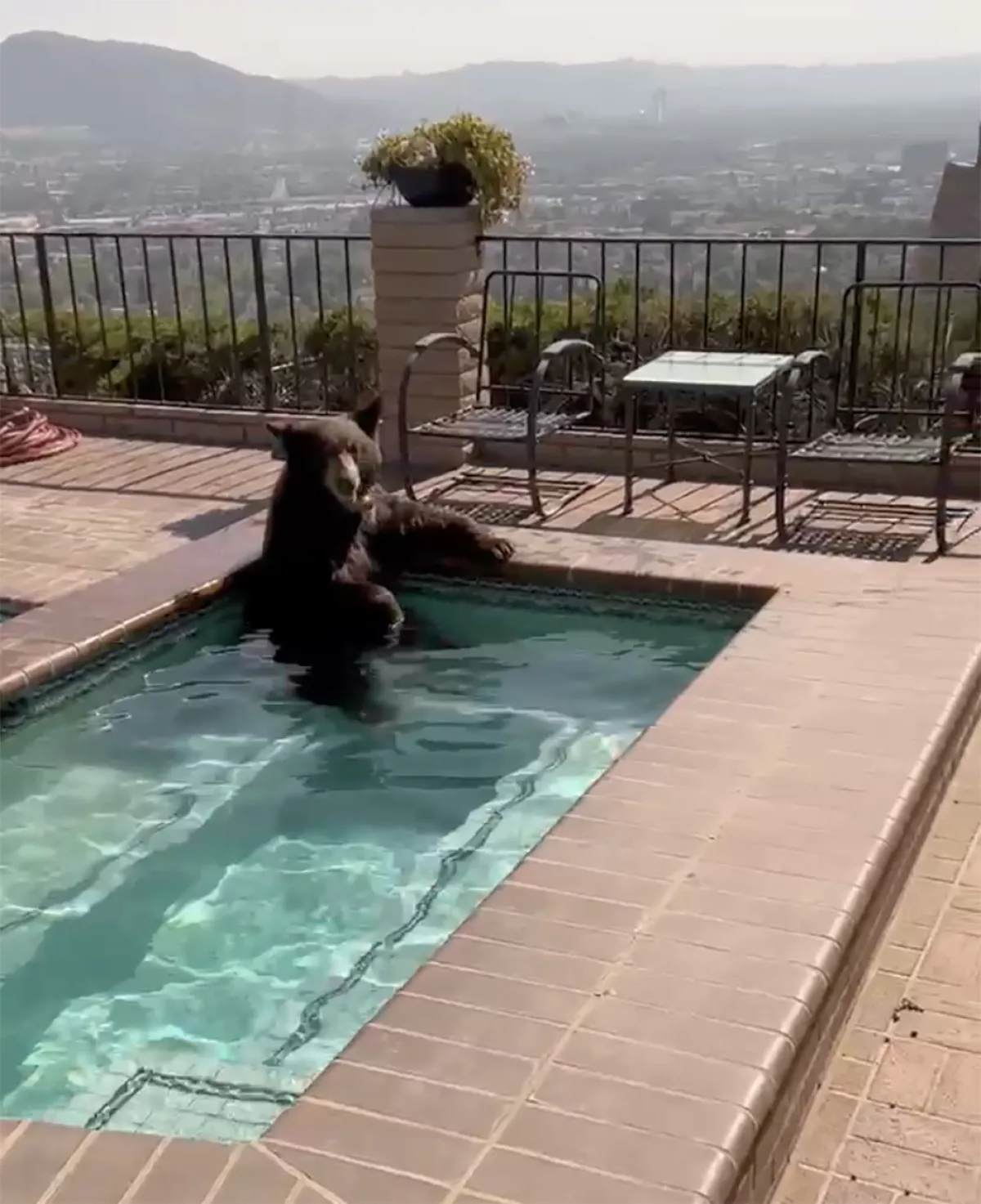
Bear takes a dip in Burbank backyard as California’s heat wave continues - LA Times
What's Weather Got To Do With Fiber Optics?
It's midsummer in the Northern Hemisphere. It's
normally the hottest time of the year and this year is setting records.
News stories are warning everyone about the dangers of hot weather since
some parts of the world are getting as hot as humans can tolerate. Hot
weather almost always means wildfires, and this year wildfires are
burning in areas not generally associated with wildfires like
California. We have had wildfires burning for months in Canada and this
week wildfires were burning even in Spain, Portugal, Tunisia, Turkey and
the Greek Isles.
It's almost time for the hurricane season to start in
the mid-Atlantic
and they are extremely disruptive to communications. Come winter,
Northern areas will get cold and blizzards and ice storms are also a
hazard for infrastructure.
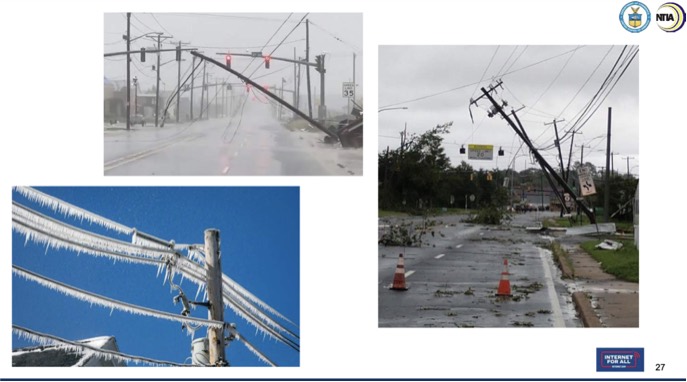
NTIA slide from TIA BEAD Success Summit
It's not just aerial cables that are at risk. We've seen flooding in
many areas during this very wet winter/spring and sea rise is
threatening many coastal cities. That can cause problems with
underground infrastructure if flooding has not been part of the design.
And winter can bring a special set of problems to underground cables.
FOA has been sent photos of splice closures that filled with water and
froze, disrupting the network. FOA was even sent a photo of a flooded
manhole that froze solid in a very cold winter. The question was how do
you thaw up a frozen manhole; the answer was wait for springtime.
The FOA has always had technical information on preparing for and restoring network outages caused by the cable plant (FOA Guide on Restoration and Fiber U MiniCourse on Restoration),
but with all the disruptive weather we have been having, several groups
have contacted FOA to ask for advice on planning and designing networks
to survive disasters. It's not a simple subject and there will be a
wide variety of conditions to plan for, but it has become a very
important topic.
Here are some things to consider right now.
Safety While Working In Extreme Heat
Temperatures above 100
degrees F (38 deg C) are no longer unusual in the summer. Techs working
on fiber optic installations and their supervisors need to understand
the risks of working in high heat and humidity and signs of worker
health issues. Last year a 24 year old fiber optic installer suffered
heatstroke while installing fiber near San Antonio, Texas which was
above 100 degrees F (38 deg C).
He and a friend had just started working as installers while they were
finishing college. According to news reports, his friend/coworker tried
to help cool him down but his supervisor, not recognizing his condition,
delayed him getting medical care and he died. (Reported in the Guardian)

Construction workers during a heatwave in San Antonio, Texas, on 27 June.
Photograph: Kaylee Greenlee Beal/Reuters from the Guardian story.
Heatstroke is a condition caused by your body
overheating, usually as a result of prolonged exposure to or physical
exertion in high temperatures. This most serious form of heat injury,
heatstroke, can occur if your body temperature rises to 104 F (40 C) or
higher. Symptoms of heatstroke may include rapid, shallow breathing,
flushed red skin, headache, nausea and vomiting, racing heart rate,
confusion, agitation, slurred speech, irritability, delirium, seizures
and coma - and death. The installer died in a hospital from severe
heatstroke and had a recorded internal temperature of 109.8F (43.2C).
Heatstroke requires immediate emergency treatment. Untreated heatstroke
can quickly damage your brain, heart, kidneys and muscles. The damage
worsens the longer treatment is delayed, increasing your risk of serious
complications or death. While waiting for medical personnel, keep the
person into the shade or cool areas indoors and cool the person with
sprays or mists of water or cold ice packs.
Companies need to ensure employees understand the risks of working in
high temperatures, a safety issue just like any other. There are many
good websites like this one from the Mayo Clinic about heatstroke that explain what to look for and how to provide emergency treatment.

For more information on heat illness prevention, go to OSHA.gov/heat.
Rural Communications Are Important To Save Lives
But Vulnerable To Natural Disasters Like Wildfires
Rural broadband and wireless have been the focus of
our attention for the last few years, especially now that the US
Government is now funding projects. For some rural projects, natural
disasters can be a big problem that is hard to plan for, especially
wildfires. California and the American West are famous for wildfires in
the hot dry summer, but this year we've also got wildfires in Canada,
Greece, and practically on every continent but Antarctica.
Unless you have been through one of these monstrous wildfires or seen
the aftermath, it is hard to conceive of the intensity of the fires, the
speed with which they can move and the destruction they leave behind. But a recent article in the LA Times
can help you understand what happens in a wildfire. They created a
time-lapse video of a wildfire on July 18, 2023 in California - the
Rabbit Fire.
The video used to create this time lapse video was taken from AlertCalifornia,
a wildfire-focused public safety program launched in May by UC San
Diego, that collects data on natural disasters. The program has more
than 1,000 wildfire-monitoring cameras across the state to study how
fires start and spread and to provide real-time data. Each camera system
has multiple camera angles for each monitored area and can view as far
as 60 miles during the day and 120 miles on a clear night. Some new
cameras are equipped with sensors that can identify hot spots and
flareups even in smoky and hazy conditions. Several of the cameras
taking these videos are on rural wireless towers so you can see how the
fires threaten the communications systems.
Here are stills from the video:
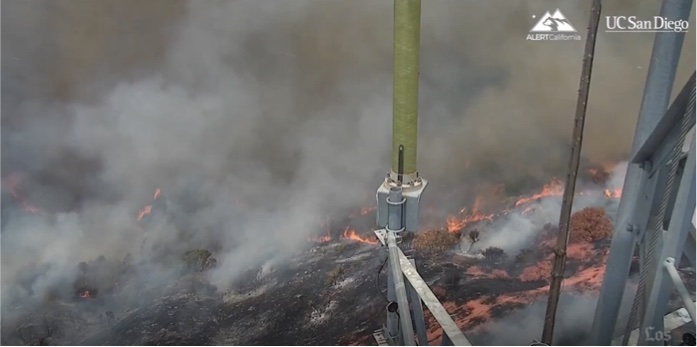
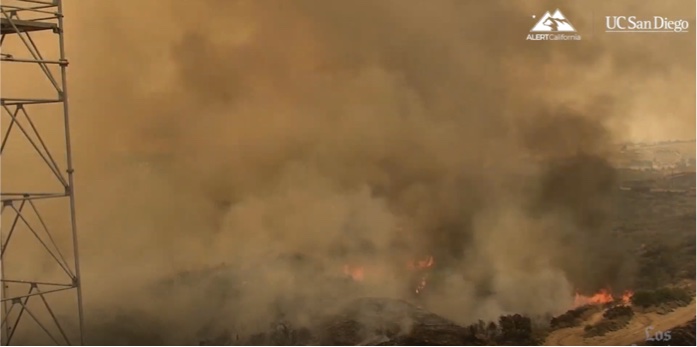
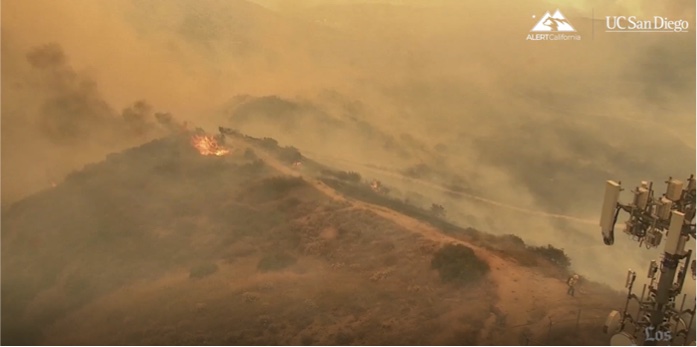
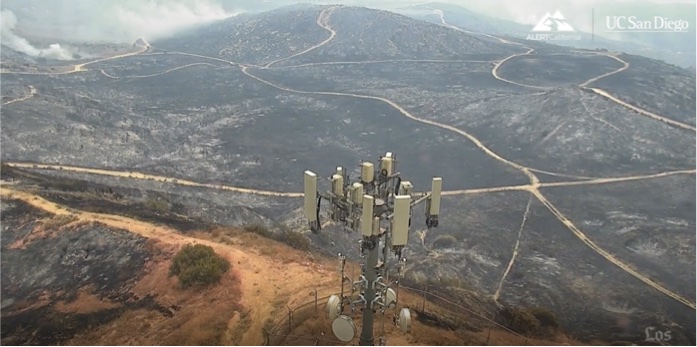
After the fire burned past this cell tower, you can see the surrounding
area is burned to the ground - the white areas are the ash left after
the super-hot fire consumed the brush and trees. Note the area cleared
around the site; it's important to prevent fire damage to the equipment.
Planning for a natural disaster like this is important but not easy. The
power company often turns off power because their aerial power cable
sometimes the cause of the fires. Even if they don't these fires can
consume wood utility poles just like trees, leaving wires - power
and communications - hanging or on the gorund. Backup power and
communications links are important to consider.
Residents of local areas often rely on their cell service for warnings
about wildfires and the need to evacuate. Loss of service can be deadly.
Planning for disaster is important as many areas have learned recently.
Wildfires And Aerial Cables
The photos above show the results of a recent
wildfire burning around wireless sites on mountains. But of course the
rural areas are mainly served by aerial cables for power and
communications. A wildfire can totally destroy an aerial cable plant as
these photos, taken after a 2007 wildfire in Southern California show.
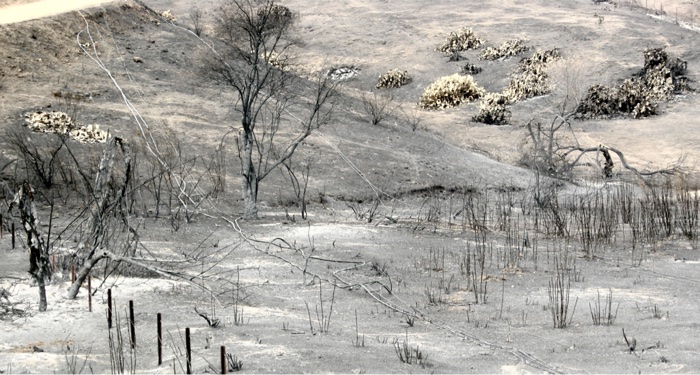
A major fire raced through this field near the I15 Freeway, leaving all
these power and communications cables laying in the ashes covering in
the field. The fire destroyed all the wooden poles, leaving the cables
on the ground. Below is an example of what the fire did to one wooden
pole.
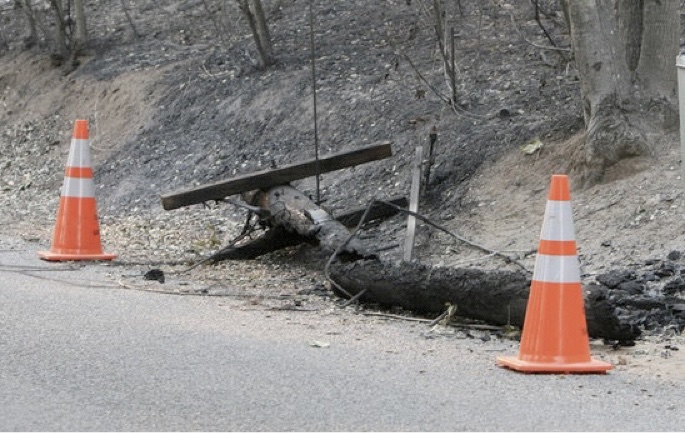
Wildfires are so hot they consume anything flammable in their path. Wood
utility poles are particularly vulnerable as old dry wood. Some
utilities in California are now converting to metal or concrete poles in
some high risk areas to help prevent losses like this. Some utilities
are considering moving infrastructure underground, which is expensive
but prevents even more expensive damages.
Preparations For Disaster Recovery
Like every fiber optic network installation project is unique, every
network disaster recovery is unique. When a disaster strikes, the first
concern is the safety of the people and as soon as possible restoring
communications to assist in the recovery process. Paramount is having
power for communications equipment, then setting up local communications
systems. Once a basic network is restored, work can begin on rebuilding
damaged infrastructure.
Disaster planning should be based on the local area. California worries
more about wildfires and earthquakes. Florida about hurricanes and
flooding. Any location in the world can evaluate the likely disaster
scenarios and incorporate it into their planning, but don't forget about
the unknown/unexpected disaster that could happen.
The FOA technical information on preparing for and restoring network outages focuses on the cable plant (FOA Guide on Restoration and Fiber U MiniCourse on Restoration),
but future work will focus on planning and designing networks
to survive disasters.
Watch for future FOA work in this area.
Good Lessons About Restoration For Managers Of Infrastructure Projects

When a section of a major highway in Philadelphia was damaged by a fire caused by a tank truck accident,
estimates of the repair time were several months or more. In actuality,
the road was repaired in 12 days, a fraction of the estimates. How did
this happen?
The story was told in a recent article in the Washingotn Post
written by Josh Shapiro, the Governor of Pennsylvania. The article
tells the whole story well but summarizes how this project was done so
quickly in just 4 points:
- Empower strong leadership
- Speed up the bureaucracy
- Encourage creativity
- Work together
The lessons learned here apply to any public works project including the
typical broadband project. You need knowledgeable leaders who know what
they are doing and how to get things done. You need the bureaucracies
that are involved in permitting, for example, to understand the project
and it's priority. Thinking creatively in a fiber project may involved
installation techniques, component selection or even choosing to use a
different network model, like building a "terabit city"
for the future. Number 4 is obvious - a project involves many workers
with different tasks, but they need to understand each of their roles
and cooperate to get their part done in time for others to do theirs.
All this is always very important, but even more so with all the US
infrastructure funding available that will involve public-private
partnerships.
Latest FOA Book: Fiber Broadband (Paperback and Kindle)
The article above points out the need for officials involved in
a project to know enough technical details about the project to be able
to make good decisions. That was why FOA created its latest book, Fiber
Broadband. It is intended to
be an introduction to broadband technology for managers involved with
broadband projects, communications courses at high school or technical
college level or for anyone
who just wonders how all this stuff works.
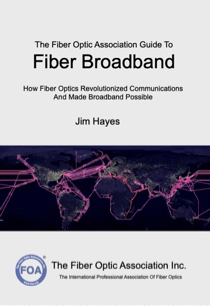
How does broadband work? Without fiber optics it would not work; even wireless has a fiber backbone.
This book is not the typical FOA technical textbook - it is written for
anyone who wants to understand fiber broadband or fiber optics or the
Internet. It's also aimed at STEM teachers who want to include
communications technology in their classes. This book will try to
explain not only how fiber broadband works, but how
it was developed.
The Fiber Optic Association Guide To Fiber Broadband Paperback ($12.95) and Kindle ($9.95) versions available from Amazon or most booksellers. Kindle version is in color!
If you work with a broadband project, contact FOA for a review copy.
BEAD Funding For The States Announced And Analyzed
How Many Techs Do We Really Need To Connect All These New Users?
What Happens When You Have Lobbyists
AI (Artificial Intelligence) For Fiber Optics?
What does A Rural FTTH Connection Cost?
What Does The Middle Mile Cost?
New Fiber U MiniCourse - Fiber Optic Jargon
There is a new MiniCourse at Fiber U - Fiber Optic Jargon.
Jargon is the most important thing you need to learn when you learn
about a new technology. This short Fiber U MiniCourse is intended to
introduce you to fiber optic jargon and make learning about fiber much
easier. It's aimed at novices but is a good refresher for even
experienced techs.
New Fiber U MiniCourse Fiber Optic Project Management
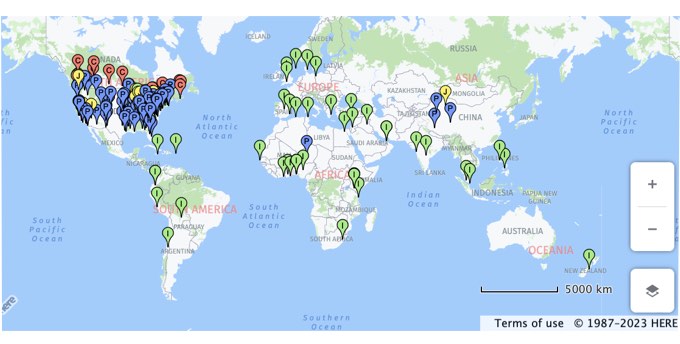
FOA has updated its online interactive map showing the FOA approved
schools around the world. The new map shows the location of FOA schools,
allows zooming in on a location and now includes a search function that
allows locating a school by name or location. Once you locate a school,
you can click on the school name and link to their website.
Cross Reference Guide to Textbooks, Online Guide and Fiber U FOA Videos Guide.
FOA has a web page with resources on fiber broadband and the IIJA/BEAD funding programs.
FOA Newsletter
Sections
News
Technical
Worth
Reading Q&A
Training/FiberU
Resoures
Safety About
|
|
News
Lots more news
in Worth Reading below
|
Old Leaded Telecom Cables May Be Environmental Hazard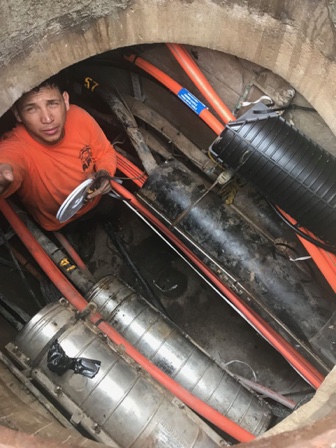 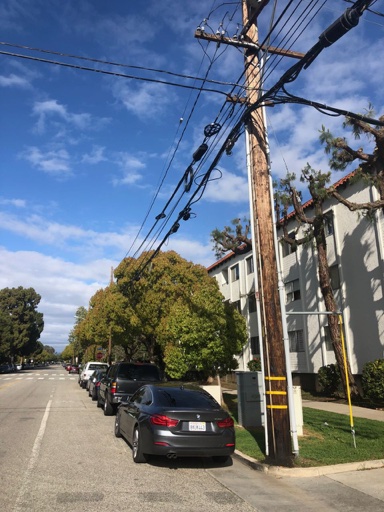
A Wall Street Journal investigative report
says that the old copper cables that telcos still have left in many
locations may be a toxic hazard. Many of these cables installed in the
early 20th century were covered in lead insulation. AT&T’s stated a
2010 presentation about employee safety said, “Underground cable
presents real possibilities for overexposure” for workers removing them.
“Some older metropolitan areas may still have over 50% lead cable,” it
added.
The paper said that lead from at least 2,000 old telco cables has
degraded over time and contaminated myriad locations in water, in the
soil and from overhead lines. Many of these locations are in places
where people live and work. Some of the locations are in schoolyards.
According to its independent tests, some lead levels in sediment and
soil measured 14.5 times the EPA threshold for areas where children
play. “Doctors say that no amount of contact with lead is safe, whether
ingested or inhaled, particularly for children’s physical and mental
development,” stated the Journal.
The U.S. has made a huge effort to eliminate lead from paint, gasoline
and pipes. But the lead-covered telco cables seem to have flown under
the radar, until now. Estimates of the amount of these cables is in the hundreds of thousands of miles of cable.
New Street Research policy analyst Blair Levin wrote that the Journal’s
story will likely result in calls to investigate from Congress and
various federal agencies such as the EPA, OSHA and the FCC.
But there are facts that aren’t clear. For example, who has the power to
force remediation; and who owns the cables? Because the lead-covered
cables in question are quite old, and because of the breakup of the old
Bell Telephone company, it can be difficult to determine which current
company actually owns the cables in any given location. In some of the
locations studied by the WSJ, telecom companies have already disavowed
ownership of the cables.
Read the full analysis of the WSJ report in Fierce Telecom. Here is the WSJ article which requires a subscription.
You Will Now Be Recognized As A Telecom Tech
The New BLS "Telecommunications Technician" Website Will Be Available September 6
 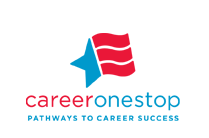
For two decades, the FOA has worked with the US
Department of Labor's Bureau of Labor Statistics (BLS) to help define
the job of fiber optic technicians. When we began, the BLS had put fiber
optic technicians in a category with "Lineman," a term from a century
ago that referred to installers of aerial electrical transmission and
distribution cables. When telephone technicians were added, they went
into that category since most cables were installed up in the air on
poles too. Fiber installers just followed the copper telephone techs
since fiber was replacing copper wires.
Around 2000, BLS contacted FOA to help define the job of a fiber optic
tech and we began what became a long term project to define the jobs.
Over this long time period, FOA has had many conversations with BLS
personnel and helped to refine the job descriptions. Finally this year, we had a new
analyst contact us and we had new ammunition - the IIJA/BEAD programs -
which was already on their minds. Everybody has been talking about the
shortage of fiber techs needed to build out the broadband networks that
are being funded (see below) so the importance of this job category was
finally being recognized.
FOA submitted proposed revisions to the BLS job definition and had
several long phone conversations. In these calls, the
conclusion was for a new category for communications workers. Together we worked out the details for a new category of
Telecommunications Technicians that would include fiber optic and
wireless techs working in a broad spectrum of jobs in communications.
Last month we heard from our BLS contact:
We received approval on the title of
“Telecommunications Technicians” for the new combined profile. My
updates and revisions are going through the review process and the new
profile will be released with our updated employment projections data on
September 6th. I have to give you credit for this. Your comments
prompted BLS to consider the change and to add the additional
occupation.
FOA is proud to have been able to get these changes made. It
will make a real difference in having good statistics on the industry
and job definitions that can be used for government funded projects.
AAPB, the American Association of Public Broadband Founded
AAPB is created to represent public broadband in the United States.
For decades, municipal networks have achieved success across
the country. Now, with AAPB, they will have a clear unified voice. AAPB will work
collaboratively with communities, policy makers, service providers, and other
industry groups to advance high-speed broadband deployments in the United
States.
AAPB embraces all members of the governmental sector,
industry/thought leaders, vendors, and advocacy groups. We understand that we
cannot connect America without the help and assistance of the entire community.
We welcome and thank you for being part of the solution.
Founded by state and local officials, AAPB is a 501 (c)(6)
non-profit organization that will build a diverse membership of public
broadband networks from around the country, and advocate in support of
municipal broadband and local choice at the federal, state, and local levels.
Gigi Sohn who has worked at FCC will be serving as
the Executive Director of the American Association for Public Broadband
(AAPB). She will also continue her work as a Senior Fellow and Public
Advocate at the Benton Institute for Broadband & Society.
More about AAPB
How Many Low Earth Orbit Satellites Does It Take To Make A Network
We have written several times about
satellite Internet and the Space-X low earth orbit (LEO) satellites
being launched to build a network. Space-X is launching satellites
weekly and currently has over 4,500 Starlink satellites in orbit. This CelesTrak graphic shown in a recent NY Times article shows how many satellites Starlink already has in orbit.
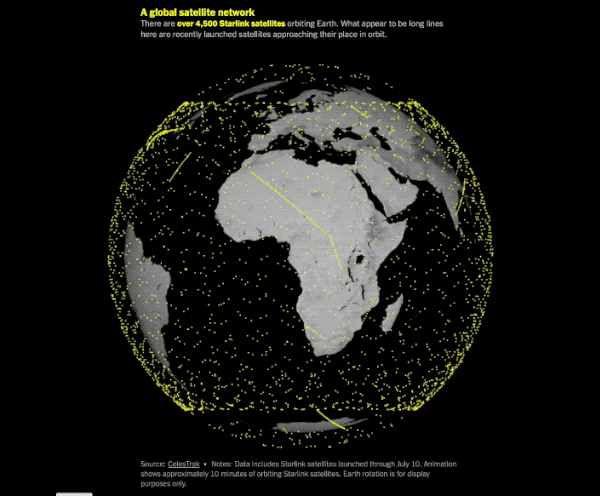
This is only 4,500 satellites; Space-X has talked about a final number
of 42,000! At 4,500 satellites, Space-X Starlink satellites are already
the majority of satellites orbiting Earth.
Beyond the communications issues, the large number of LEO satellites are
affecting ground-based astronomy. Below is a long exposure photo by NSF
of a double star (Albireo) showing the effects of LEO satellites on
observations.
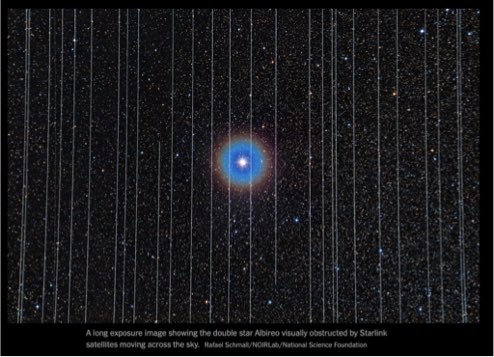
Read more about Starlink in the NYTimes.
Community College Grads Can Earn More Than Elite University Peers
After a yearlong training program at Los Angeles Trade-Technical
College, Elijah Calderon is poised to earn about $105,000 annually as a
power lineman. Once he becomes a journeyman in three to four years, he
stands to make about $165,000 — and potentially much more with overtime.
His chosen field in the community college system will propel him to the
top 5% of wage earners among recent California college graduates —
outearning many who attended the most prestigious universities in the
state and the nation.
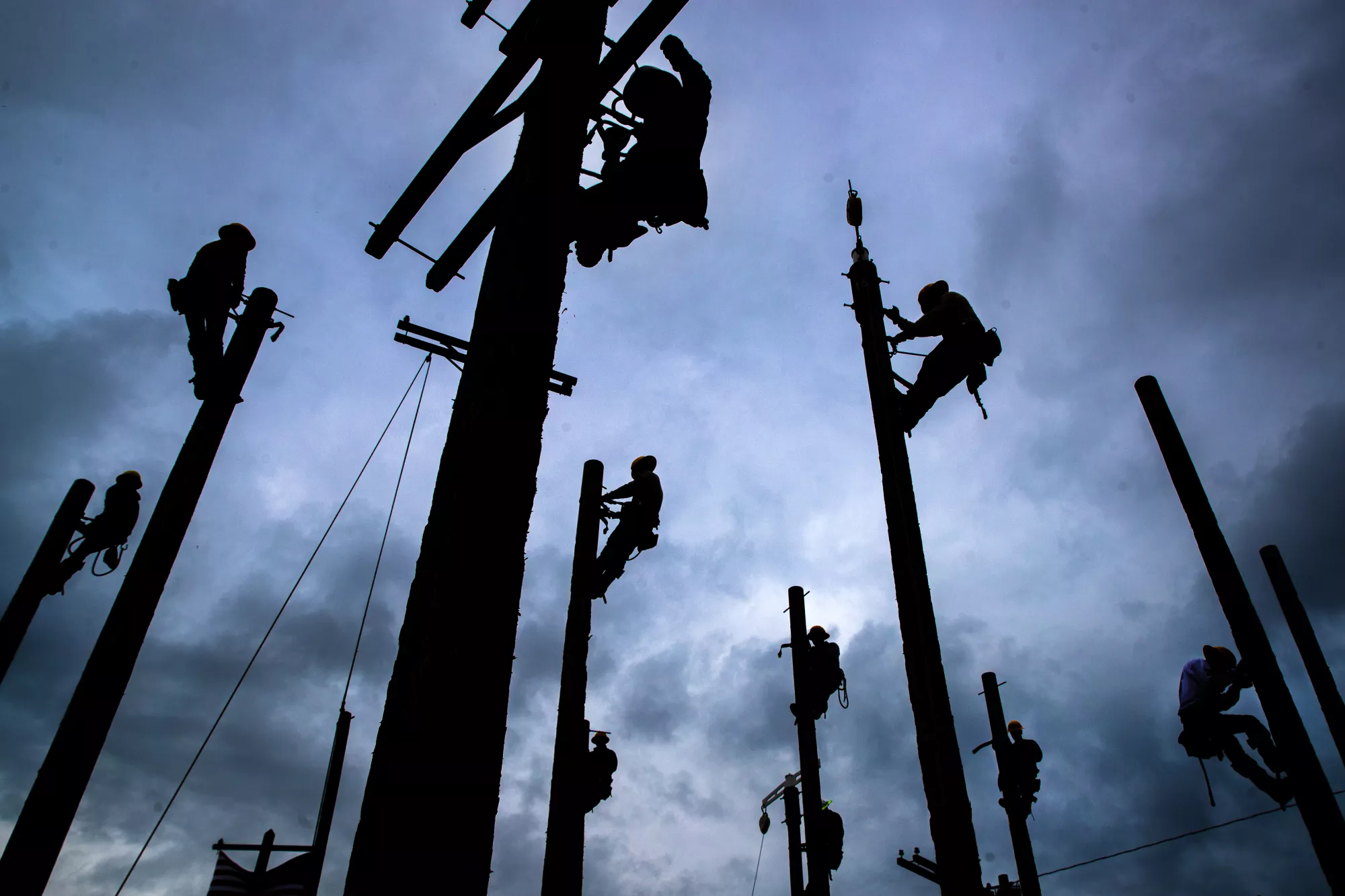
As millions of high school and college students graduate this month to
pursue higher education or launch newly minted careers, the data
highlight the powerful role that their majors play in determining
post-graduate earnings regardless of the prestige of the institutions
they attend. The analysis comes amid growing scrutiny over the value of
college degrees — and whether higher education is worth the rising
costs.
Los Angeles Trade-Technical College has been one of the many technical
and community colleges in the FOA network of approved schools for more
than a decade. Besides the electrical tech major featured is this
article in the LA Times, LATTC offers majors that include courses in
fiber optics with a FOA CFOT certification and premises cabling for a
FOA CPCT certification.
“It really pays to look at outcomes and not be blinded by the brand
name,” said Martin Van Der Werf of Georgetown University’s Center on
Education and the Workforce. “The best brand name doesn’t necessarily
mean it’s going to result in the highest life earnings.”
Read more in the LA Times newspaper.
TIA BEAD Success Summit Presentations Available
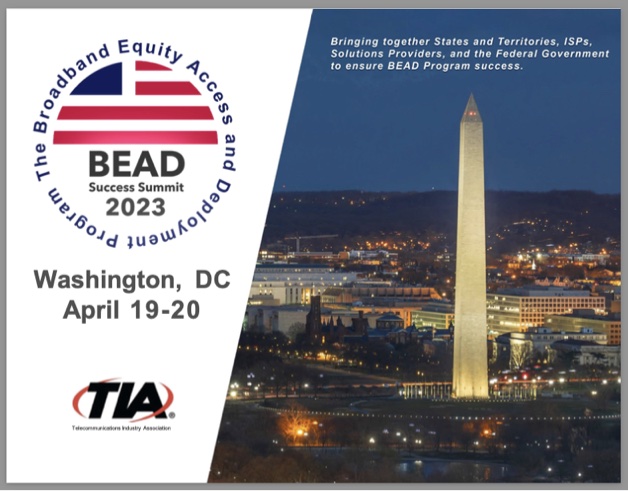
Slides and videos from the TIA BEAD Success Summit are now available online. There are some interesting presentations and information here.
Registration Open For ISE Expo 2023

ISE EXPO 2023, the OSP telecom conference, showcases the next wave of
disruptive products, technologies and solutions for todays' and future
networks. It's a conference for the professional who plans, builds,
operates and maintains these networks. At ISE EXPO 2023 you can see,
touch and demo new products, technologies and solutions for telecom
networks.
Join ISE EXPO 2023 in Kansas City, Missouri, and experience why network
professionals from around the globe attend our engaging seminars,
commanding keynote presentations, solutions-based vendors and
face-to-face networking.
More about ISE Expo 2023 (and early bird discounts)
Global Excavation Safety Conference 2024 in New Orleans

Global Excavation Safety Conference will be held in the city of New
Orleans, Louisiana, from March 19-21, 2024. This is an opportunity for
damage prevention & excavation safety professionals from all over
the world to come together and learn, network, and share their knowledge
and expertise in this vitally important field.
More info on Global ESC 2024
|
Technical
Fiber optic
technology, standards, equipment, installation,
etc.
The FOA
Update Page covers the new technology
and applications we covered in this newsletter
recently. Now you can review all that new tech at
once.

Cross Reference To FOA Technical Reference Materials
The FOA has almost 1,000 pages of technical information on the FOA Guide,
100+ videos and two dozen online courses at Fiber U, all this can make
it difficult to find the right information.
Cross Reference To FOA Tech Materials
To help this, we have created a cross reference guide to the textbooks,
Online Guide and Fiber U courses, all the FOA technical information.
Besides the textbooks, online Guide and Fiber U, each section of the
Guide also includes links to the 100+ FOA videos available.
Cross Reference Guide to Textbooks, Online Guide and Fiber U
FOA Videos
We have also rearranged the 100+ FOA videos in similar categories on the
Contents Page of the Online Guide, making the videos, especially the
lectures, much it much easier to find a video on a particular
topic.
FOA Videos Guide.

Want to know more about fiber optics? Study
for FOA certifications? Free
Self-Study Programs are on Fiber
U®
|
 OptConn
is a value-add re-seller of optical connectivity products, services and
solutions. With over 30 years of experience in the fiber optics
industry we are here to serve your requirements from fiber optic
training with FOA certification to products, materials and supplies. OptConn
is a value-add re-seller of optical connectivity products, services and
solutions. With over 30 years of experience in the fiber optics
industry we are here to serve your requirements from fiber optic
training with FOA certification to products, materials and supplies.
We have partnerships with industry leading
manufacturers to support your installation, splicing and testing needs.
Our goal is to guide, support and recognized our client’s requirements.
Learn more about OptConn
|
Note: FOA has run many articles and photos about poor
installation of aerial cables. Here is a report about similar problems
in Eastern Europe.
Examples of Poor Installation of FTTH In Customer Premises
Until 10-15
years ago when fiber to the home (FTTH) became possible, HFC (hybrid fiber coax CATV) with a cable modem was the best
solution for broadband services. Internet service over the telephone network
was very bad, and CATV companies did not have real competition. Because of
that, all buildings had HFC installation.
Nowadays, the
FTTH is the best access network which enables high quality broadband services.
Today, every new building has FTTH installation. Telephone cables and coaxial
cables are not installed. The installation process of FTTH installation is
completed during the building construction process. In this way, ducts, pipes,
cables, etc. are not visible. All of this equipment are in the wall.
One of the main
problems with old buildings is high quality broadband services. In situations
when tenants do not allow installation of a new FTTH network, telecommunication
companies must use FTTx scenarios with old copper cables (telephone, coaxial,
or UTP cables) with MoCA, G.fast, or G.hn technologies.
Usually, tenants
do allow the installation of a new FTTH network. Then, telecommunication
companies have to pay attention to neatness and quality. A bad installation can
have a very bad company reputation, and very often, serious negative effects
which can stop the next installation in another building.
In this article,
We will show many bad examples of indoor construction in FTTH networks. Many
telecommunication operators want to cut costs and use low-quality, incomplete,
or inadequate equipment, as well as untrained low-paid staff. In these
examples, the main problem is untrained or inexperienced staff.

See more examples and read the rest of the article here.
Vladimir
Grozdanovic is a graduate electrical engineer for telecommunications
with more than 10 years of experience in access networks (HFC and FTTH)
in large cable operators in Serbia (SBB and Jotel).Inside:
What's Inside: Corning Rocket Ribbon 864 Fiber Cable
The Corning Rocket Ribbon 864 fiber cable we
used last month to illustrate the important information printed on the
jacket of a fiber optic cable is a typical high fiber count cable built
around conventional ribbons of fibers, not flexible ribbons. We opened
up this cable so you could see the cable construction.
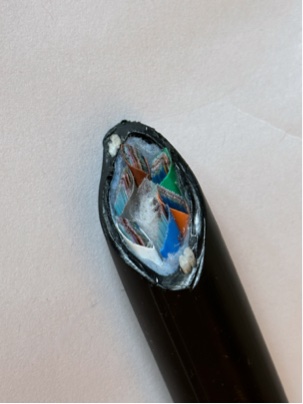 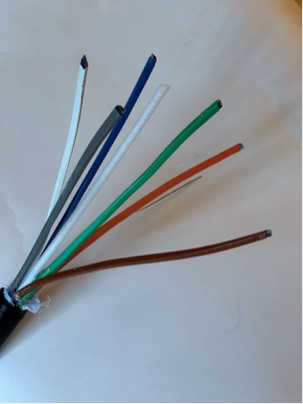 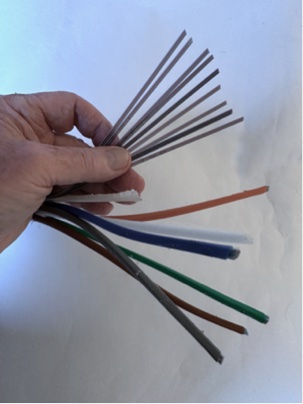
Looking at the cable end, you can see how dense
the cable is. Packed into this small cable are 6 color-coded bundles of
144 fibers, 12 ribbons of 12 fibers each, and a central foam member to
separate the bundles of ribbons. This is a central tube cable with dual
fiberglass strength members on opposite sides inside the jacket. The
third photo shows the 12 ribbons in one of the tubes.
Opening this cable to get these photos showed us that this is a cable
that requires reading the directions carefully to access the fibers
without damaging them. Here is the Corning application note on this cable.
Below is the information printed on the cable jacket.
Reading The Important Information On The Cable Jacket
While walking down the street near the FOA office, we found this cable
laying in the gutter. What a find! A short length of Corning Rocket
Ribbon 864 fiber cable left over from an installation by a contractor.
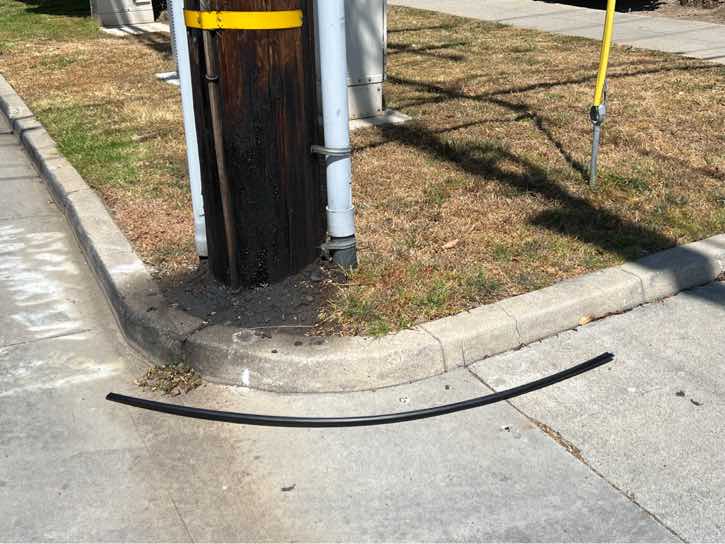
We brought the cable back to our office with the intention of opening it
up and creating a video about the construction of this modern high
fiber count cable, but something got our attention first. The cable had a very
long line of printing on it with lots of interesting and useful
information. So before we started deconstructing it, we decided to
photograph the printed information and interpret it.

Click on the photo above for a bigger photo. Or read on.

The text on the cable starts with the Corning product name "Corning
Rocket Ribbon (TM) Optical Cable," date of manufacture "01/2022" and a
serial or build number. The phone handset graphic denotes this as a telecom
cable.

Here is the most important information:
- 864F means the cable contains 864 fibers
- SM means singlemode fiber
- 250 means the fiber has a 250 micron buffer coating
- 0.89IN means the cable has a diameter of 0.89 inches (metric would be in mm)
- 206 LB/KFT means the cable weighs 206 pounds per 1000 feet (metric would be kg/km)
- MBD 27IN means the minimum bend diameter is 27 inches (metric would be in mm or cm)
- 600LBF means the maximum pulling tension is rated at 600 pounds (metric would be in Newtons)
There is a lot of information in those few inches along the cable, information that
every installer needs to know.
Since it is an OSP cable, we assume it is
singlemode fiber, of course.
When you are fusion splicing this cable you need to know the coating
diameter for choosing the proper fixturing for your fusion splicing
machine.
The weight of the cable is important if the cable is being lashed to a
messenger because it is used to calculate loading on the messenger and
can determine the size and tension on the messenger.
The minimum bend diameter
is important if the cable is being coiled or pulled over a capstan,
sheaves or blocks. And the pulling tension applies if the cable is
pulled, not in the case of aerial installation like this one.

The next text is the cable model number and the length. "SR-5B9MR-864" is a Corning SST (Single tube) UltraRibbon Gel-Free Cable with low water peak fiber.
And finally, the cable has distance marked - "00030 FEET" - on this
cable it's updated every 2 feet. knowing how much cable is on the reel
or the distance at the other end of the cable on the reel allows keeping
track of how much cable was used and how much was left.
Here is an excellent example of why you need to learn to
read cables. There is a lot of useful information and some is critical
for proper installation of the cable. On the next job, take a minute and
read the cable you are installing; you might learn something
interesting and useful too.
Note: This is an outside plant cable. Indoor cables should have similar
information but also include some note of being tested for flammability
such as a UL registration.
Next we will continue examining and dissecting this cable - maybe next month.
New Tool For Wet/Dry Cleaning
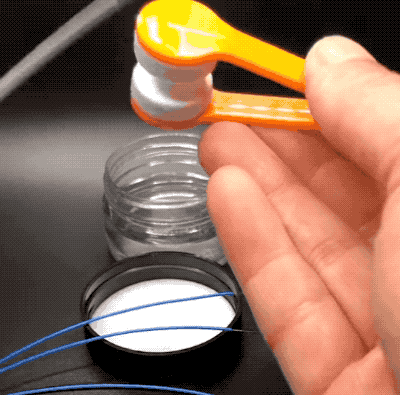
Optix QuickCleans clean fiber faster and also avoids skin exposure to repeated use of cleaning solutions
The QuickClean tweezer design includes lint free pads for superior
cleaning and a loop tie down on end to prevent from getting lost. They
can be used wet or dry and are made of non-woven, high density,
hydro-entangled, 45/55 cellulose/polyester blend for optimum purity.
High strength with excellent absorbency, these QuickCleans are tested to over 100 uses each before they can be discarded. Ten QuickCleans per pack plus one fluid bottle (1 ounce).
More information and a datasheet.
Microtrenching - More Vulnerable To Cable Cuts?
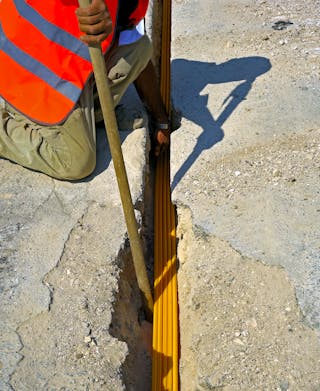
Germany may be having more problems with dig-ops because of
microtrenching, although the real problem may be documenting the cable
plant and contractors not using available location information before
beginning digging. A recent article in Cabling Installation & Maintenance
has news from Germany that Deutsche Teleom cables installed by
microtrenching are vulnerable because they are "just a hands-breadth
under the asphalt." The article further states that Germany has around
100,000 accidental cable cuts per year.
This is of course a problem everywhere, but especially in urban areas,
even worse in older urban areas. Streets re full of fiber and copper
communications cables, electrical cables, water, sewer and gas pipes.
Careful documentation is vitally important but so is checking the local
"Call Before You Dig" service and using locating instruments before
digging begins.
Read more in Cabling Installation & Maintenance.
NATE Video On Work Zone Protection
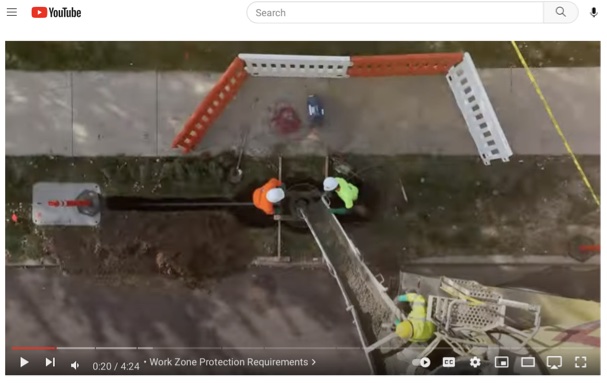
NATE: The Communications Infrastructure Contractors Association
announced today the official release of a video on Work Zone Protection.
The video shines a spotlight on the safety best practices associated
with Work Zone Protection, specifically relating to the appropriate use
of temporary traffic control devices, proper signage, the type of PPE
safety gear technicians working in these environments are required to
wear, and the different scenarios workers are confronted with while
deploying fiber, network equipment, and communications infrastructure in
areas near pedestrian and traffic flow.
Watch the video here.
Problems With Old Cables And New High Fiber Count Cables?
A FOA CFOT reported that they have been doing fiber characterization
testing on cable plants that include both old and new fibers, a common
result from building out from a legacy cable plant. One surprising
result was that some relatively short links are showing CD and PMD
problems even when only short segments of the cable plant are older
fibers. PMD has become an issue as speeds increase but earlier fibers we
not optimized to prevent PMD. This is just another reason to do fiber
characterization before trying to upgrade network speeds. (There is more
information on Fiber Characterization in the FOA Guide and a fiber characterization course on Fiber U.
We're also hearing rumors that the new high fiber
cables are getting fibers broken
during installation with the possible cause(s) being exceeding bend
radius or pulling tension, using improper installation equipment or
maybe even the cable designs. We're investigating this and will report
back in the near future. But please ensure installers follow
manufacturer's recommendations carefully. Check out the information on
cable specs in the article in this issue and the article on Bending Diameter in the FOA Guide.
Special For High Level Techs And Engineers:
Standards and Testing Photonic ICs
Point to Multipoint Networks at Infinera
Managing Fiber Optic Projects - The Gantt Chart
(With An Excel File To Make Your Own)
The most common way to track projects is the Gantt Chart, a
chart of activities that tracks the progress of projects along a
timeline. each activity is represented by a bar and the position and
length of the bar represents the starting date and duration of the
activity. This allows you to see what activities are needed for the
project, when the activities start and end so it can be used to track
the progress of the project visually. Here is what a Gantt Chart for a
fiber project might look like:
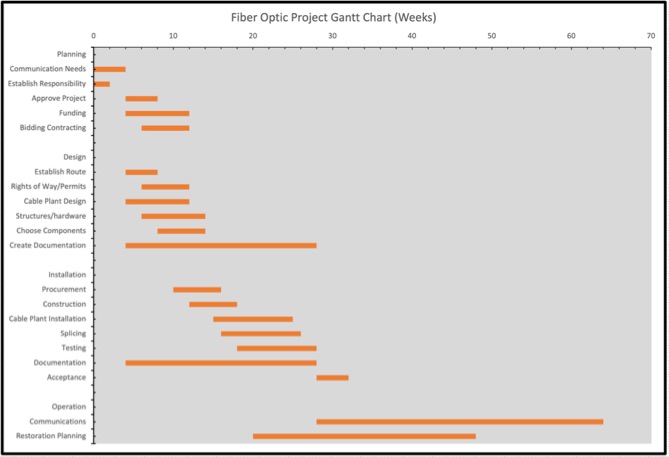
You might remember an article in the FOA Newsletter in April 2022 or the FOA Guide page on Project Management about the timing of a fiber optic project where we showed the progression of steps in a project like this:
The Gantt Chart above is simply this list converted to a Gantt Chart
using a Microsoft Excel spreadsheet. You can download a copy of the FOA Gantt Chart spreadsheet (xlsx file - 16kB)
and use it to create your own Gantt Chart for any project. All you have
to do is to input your own data and change the activity names as
necessary. You can also follow the directions from Microsoft to create your own version.
More Help On Color Codes (Including Copper Cabling And Fiber Optics)
The FOA has created a print-your-own pocket guide to fiber
optic color codes. It has
color codes for fibers and buffer tubes, connectors and premises cables
inside and on the back, QR codes to take you directly to the FOA Guide
and Fiber U.

The FOA
Guide page on Fiber Optic Color Codes is one of the most read pages on the FOA
website and the Fiber Optic Color Codes minicourse on Fiber U very popular also.
Here's a do-it-yourself FOA Guide To Fiber Optic Color Codes card.
Just download the PDF file, print it on a color printer and fold it up
as shown. Then you have your own pocket guide to color codes. Make a
bunch for your co-workers too.
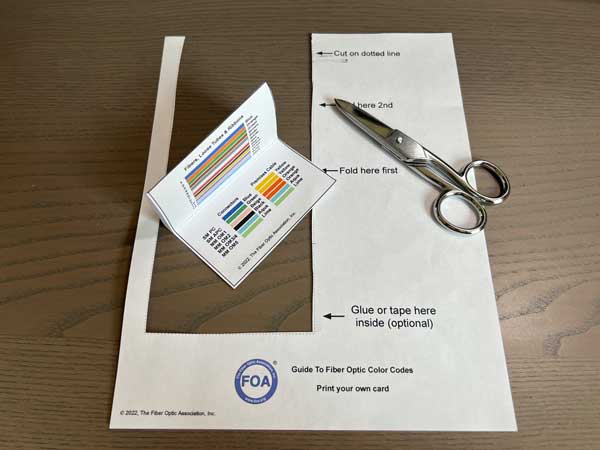 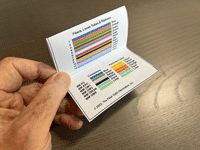 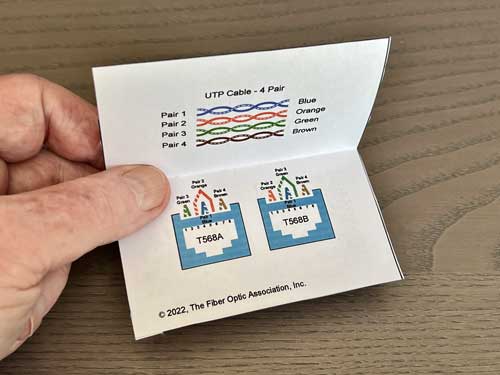
Then we realized that many of your also do structured cabling
work, so it was a natural to add a Color Code Guide for UTP copper
cabling in printable (below) and electronic (above) versions.
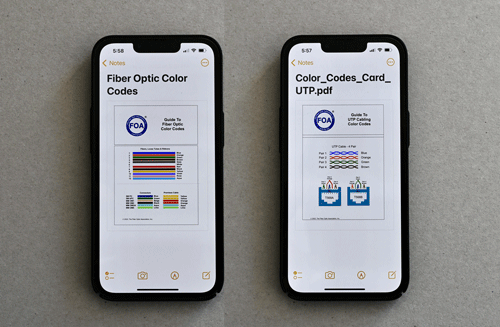
But we did not stop there. We know how many of you use your mobile devices on the job, so we created a version of the Color Code Guide you could download
and use on your smartphone or tablet. It's a PDF file, so you just
download it and save it on your device and it will be with you always.
Here are the links to download your own FOA Guides to Fiber Optic Color Codes
FOA Guide to Fiber Optic Color Codes (print your own version) PDF
FOA Guide to Fiber Optic Color Codes (electronic version for your smartphone, tablet or PC) PDF
And For UTP Cabling
FOA Guide to UTP Cabling Color Codes (print your own version) PDF
FOA Guide to UTP Copper Cabling Color Codes (electronic version) PDF
Warning For Techs Doing OSP Restoration

FOA received an inquiry about whether techs
working on restoring OSP links should be concerned about eye safety if
the link used fiber amplifiers. To answer this question, we had to do some research on fiber amplifiers.
The short answer is YES, you should be concerned. The long answer is
more technical and includes details that every OSP tech needs to know.
See "Fiber Amps And Restoration" in the FOA Newsletter Archives..
Try The FOA's Online
Loss Budget Calculator
FOA
has written many articles about loss budgets,
something everyone involved in fiber optics needs to
know and needs to know how to calculate. We've
created a online Loss Budget Calculator that does
the work for you. Just input your cable plant data
and it calculates the loss budget. It works on any
device, especially smartphones and tablets for field
use and even allows printing the results.
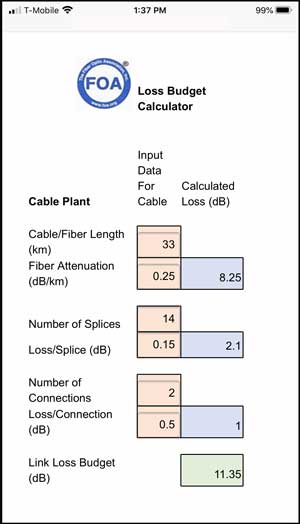
Bookmark
this page (especially on your smartphone): FOA Loss Budget Calculator
Online
|
Worth Reading
Each month we read
hundreds of newsletters and online articles. These
are the ones we think you will find "worth
reading."
FOA has a web page with resources on fiber broadband networks and the IIJA/BEAD funding programs.
Cross Reference Guide to FOA Textbooks, Online Guide and Fiber U
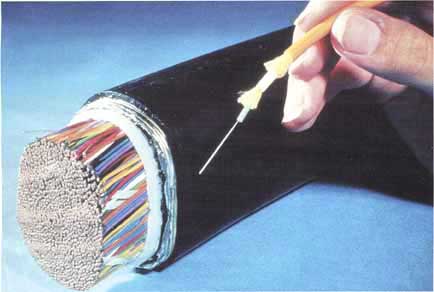 AT&T PR photo from the mid 1970s AT&T PR photo from the mid 1970s
The FOA's History
|
Worth Reading (And
Watching):
August 2023
Recycling Optical Cable Scrap In India - a leader in plastics recycling. Grit Industries recycles plastics and optical fiber cable for India. Watch their video introduction here.
Biden-Harris Administration Announces Nearly $1 Billion in New Internet for All Funding Available to Tribal Lands
More communities building own broadband networks - ILSR
Demystifying Next Generation Fiber Workforce Development
- ISE Magazine - it's becoming clear that the gap is not due to a lack
of available training programs, but rather a lack of general interest
among new generations in pursuing telecom trade jobs.
19-core optical fiber is the world’s fastest - Laser
Focus World - An advancement in optical fiber produces the equivalent
of 10 million high-speed home internet connections at full capacity.
July 2023
Can Our Industry Develop Fiber Talent?, FOA President Jim Hayes' May/June column, ISE magazine.
Why the U.S. Electric Grid Isn’t Ready for the Energy Transition NYTimes,
Electric vehicles, heating, etc. are being promoted as climate friendly
alternatives to fossil fuels if the eelctric supply is from renewable
sources, but can the grid handle that?
Office of Internet Connectivity and Growth, 2022 ANNUAL REPORT. U.S. Department of Commerce.
National Telecommunications and Information Administration
June 2023
Bringing FTTH Broadband to Remote and Rugged Areas - Broadband Properties - By Michael A. Solitro, CEO of Sertex Broadband Solutions.
NTIA Says State Muni-Bans Won’t Delay BEAD Funding - ILSR says "Maybe"
US Proposes Designating Portion of Radio Spectrum for 5G in the Americas Nextgov.com If approved, the proposal could enable countries in the Americas to use the band to deploy 5G mobile services.
Significant progress reported on California middle-mile network - CA Dept of Technology
Recent Case of Severe Microwave Syndrome Reveals Problems With 5G - Epoch Health -
One woman's recent illness highlights the issue of only considering radiofrequency radiation's thermal effects
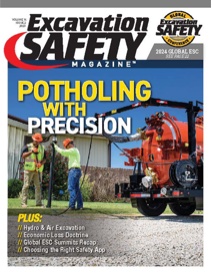
The Summer edition of Excavation Safety Magazine is online
May 2923
Do You Believe In Magic? Sufficiently advanced technology is indistinguishable from magic. Jim Hayes's column in March/April ISE Magazine.
After federal investment, supply chain jams and labor shortages still hinder tribal broadband access - Marketplace on Public Radio
Fiber To The Office (FTTO) On A College Campus In The Netherlands - NEXANS
Bipartisan Push To Make Broadband Grants Tax Exempt Moves Forward - ILSR COmmunity Networks (Something overlooked in the original program!)
Special For High Level Techs And Engineers:
Standards and Testing Photonic ICs
Point to Multipoint Networks at Infinera
Telegeography Submarine Cable Map 2023 - You can also buy copies - Telegeography
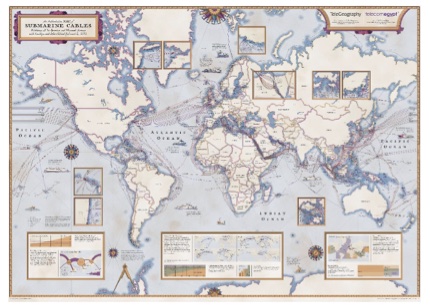
March 2023
CABL® (cabl.com) serves
the business needs of the Broadband industry (including traditional
cable TV, fiber, telecom and satellite providers) with employment
listings, classified ads, discussion forums, and more. A contractor told us it's where they find lots of opportunities for subcontracting.
The Secret to Future Proofing, by Jim Hayes, FOA President, ISE Magazine
The 45 Year Old Overnight Sensation - article by FOA President Jim Hayes in ISE Magazine (Read the complete Nov/Dec issue of ISE Magazine here.
Fiber
optics take the pulse of the planet It’s like radar, but with light.
Distributed acoustic sensing — DAS — picks up tremors from volcanoes,
quaking ice and deep-sea faults, as well as traffic rumbles and whale
calls. Knowable Magazine.
Worth Reading - Magazines, Websites and Newsletters
CABL® (cabl.com) serves
the business needs of the Broadband industry (including traditional
cable TV, fiber, telecom and satellite providers) with employment
listings, classified ads, discussion forums, and more. A contractor told us it's where they find lots of opportunities for subcontracting.
New Fiber Optic
Magazine In Spanish
Todo Fibra Optica is
a new digital magazine in Spanish for fiber optics
in Latin America and South America. Jose Enriquez, editor of Todo
Fibra Optic magazine has many years
experience in the fiber optic industry so he knows
the industry well. FOA will be working with him to
share our extensive technical materials in Spanish.
Read their newsletter here. It is now available online in English and Spanish.
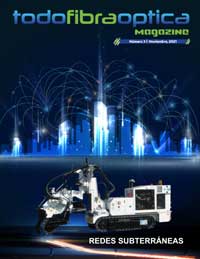
All issues and subscriptions.
Contact:
José Manuel Enriquez Mora, Editor
Todo Fibra Optica LLC
https://todofibraoptica.com/revista-ediciones/
+52 222 302 8224
jose.enriquez@todofibraoptica.com
RTI Telecom Magazine from Brazil, in Portuguese. A revista RTI do mês de abril já está disponível online e recomendo a leitura de alguns artigos:
1995-2020
- FOA's 25th Anniversary!
As
part of celebrating 25 years of serving the fiber
optic industry as its primary source of technical
information and independent certifying body, FOA
thought it appropriate to create a short history of
the organization and how it has developed to
help the fiber optic industry. We also wanted to
recognize the contributions many people have made to
the organization over the years that made FOA what
it is today.
The FOA history is now archived on the FOA
website where you can read it anytime or link to
it. Updated
info - dB, total internal reflection and science
projects,
Worth Reading - News
Summary - Past Links Worth Repeating
ESRI has created an ebook on GIS location technology for telecom. Use the link to download the book.
The First Transcontinental Telephone Line
began operation on July 29th in 1915 - 3400 miles between New
York and San Francisco - required over 100,000 telephone poles! Wonders
of World Engineering
1983
Video of AT&T's First Test Of A Submarine
Cable System From the AT&T Tech
Channel archives (worth exploring!)
Richard
Epworth's Optical Fiber History from his work
at STL from 1966 with Charles Kao.
Communications Systems Grounding
Rules: Article 800 provides specific
requirements by
Michael
Johnston, NECA Executive Director of
Standards and Safety in EC Magazine
US Broadband Coverage By Service
Provider from the FCC
How
To Build Rural Broadband, Learning From History
In the August 2021
FOA Newsletter, we published a lengthy article on
rural broadband and compared it to rural
electrification in America in the last century.
Much of the comparison was based on an article
written in 1940 by a USDA economist, Robert Beall,
called "Rural Electrification."
If
you are interested in or involved in rural
broadband, we recommend you read the article "How
To Build Rural Broadband, Learning From History"
in the August 2021 FOA Newsletter and
read the Beall article also.
Recycling Fiber Optic
Cable - Contact:
Steve Maginnis
LD4Recycle/ CommuniCom Recycling
(Visit
website)
sm@LD4Recycle.com
803.371.5436
"Who Lost Lucent?: The
Decline of America's Telecom Equipment Industry"
This is a MUST READ for managers in telecom or any
industry!
This long and
well-researched and annotated article in American
Affairs Journal should be mandatory reading
for every high level manager in a telecom company -
or any other company for that matter. To summarize
the article, today, America has no major telecom
equipment company and fears the major suppliers of
equipment who are all foreign, especially the Huawei
from China. This article explains how America got
into this deplorable state.
OFS also has an excellent
website and blog of tech articles worth browsing.
IEC 60050 - International
Electrotechnical Vocabulary - An
extensive dictionary for fiber optics in English and
French. Highly technical - this is one definition:
"mode - one solution of Maxwell's equations,
representing an electromagnetic field in a certain
space domain and belonging to a family of
independent solutions defined by specified boundary
conditions"
If you are interested in restoration -
aren't we all? - you should also read this
article in dpPro magazine by FOA President Jim
Hayes: Damage Protection Requies
Looking Overhead As Well As Underground
- dpPRO Magazine - about the problems with
aerial cables. His previous article for the
magazine was New Techniques for Fiber
Optic Installation. The Institute for Local
Self-Reliance weekly newsletter has
lots of interesting articles and links.
Universal access to broadband
is a cornerstone to a strong economy,
Achieving universal access will require
community partnerships. by Alfreda
B. Norman, Sr. VP, Federal Reserve Bank of
Dallas
FIBER TO THE FARM: The
co-ops that electrified Depression-era farms are
now building rural internet. Be sure to check out
the high-tech equine installation equipment.
Next Century Cities Newsletter
- News from cities around the US
including Detroit and New York plus small
Infrastructure Get Some
Respect, NY TImes "On Tech"
"The magic of the internet requires a lot of
very boring stuff behind the scenes. "
DIRT
Report On Damage To Utilities Common Ground
Alliance (CGA) annual DIRT report provides a
summary and analysis of the events submitted into
CGA’s Damage Information Reporting Tool (DIRT) for
the year 2018. The complete report is available
for download here. In addition,
there is an interactive dashboard that
allows users to filter the data more by
factors contributing to damages.
Structured Cabling News
- a website and weekly newsletter about cabling.
Fiber Trivia From
Corning.
The
Future Of Work Is Skills - So Stop Worrying
About Degrees - The
reality is the future of work is about skills, not
just degrees. (FOA Newsletter Feb 2020)
The job market is hot. So why
are half of U.S. grads missing out?
VIAVI Books On
Fiber Optic Testing (2 volumes) - They're back!
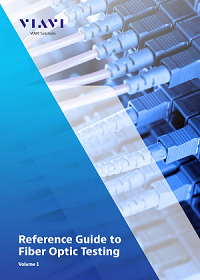 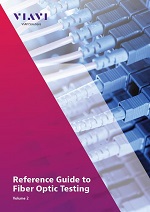
Besides
the FOA reference materials, two JDSU/VIAVI
textbooks, Reference Guide to Fiber Optic Testing,
Volumes 1 and 2, were used as references for
some of the FOA courses and are recommended for
instructors and students. The books are available
from VIAVI as eBooks and the everyone should
download them and recommend them to others.Download
yours now. Volume 1. Volume 2. Viavi Books
Ciena's Submarine Cable
Handbooks (4 to download)
Guidebook To MPO
Testing OptoTest
offers this complete guide to MTP®/MPO testing. In
this guide, you will learn all there is to know
about the different test methods, equipment
options, troubleshooting, and best maintenance
practices to ensure that you have the best testing
experience. Go here to download the book.
50th Anniversary of The
Development of Low Loss Fibers A history
of the development of low loss fiber, a fascinating
story by Jeff Hecht on the OSA (Optical Society of
America) website.
How OFS Makes Fiber
Interesting YouTube video on how fiber is made.
Perhaps a little too much "show biz" but
fascinating. If you have ever seen fiber
manufacture, look at this video. You will be amazed
at how big preforms have become!
The True Cost of Telco Damages
(what backhoe fade or target practice can
cost)
Rural Electric Cooperatives:
Pole Attachment Policies and Issues, June 2019.
Clearfield-FOA Certification
Training Clearfield is now offering
their customers an FOA
CERTIFICATION course. This course
provides a basic understanding of fiber optic
technology, as well as Clearfield product
knowledge and how Clearfield’s integrated product
systems work together in a fiber network.
Substandard Contractors - Fiber
Optic Knowledge Doesn't Always Trickle
Down (EC Mag)
|
Q&A
When readers ask us questions, we generally refer them to FOA
resources where they can find the answer to their question and many
more. We first send them to the FOA Guide
which is the table of contents for the FOA technical resources. There
they can find pages indexed by topic and a search engine for the FOA
website. It also links them to FOA videos and courses on our free online learning site Fiber U.
The FOA
Fiber FAQs Page (FAQs = frequently asked
questions) gathers up questions readers have
asked us (which first ran in this newsletter)
and adds tech topics of general interest.
|
Good Question!
Tech
Questions/Comments From FOA Newsletter Readers
August 2023
Test Cables With Network Transceivers And A Power Meter.
Q: Can I test my singlemode cables with just a power meter and the network transceivers?
A: Yes, using the transmitter in the transceiver as a test source.
Since you don't have connector-to-connector mating adapters, use a cable
substitution test.
Basic process: test cables by:
Set meter to 1310 nm and dBm
Connect patchcord to transceiver output, measure power. Repeat will all
transceivers, all patchcords, reversing each and looking at average
power. Should be nearly the same.
Connect 600’ cable to transceiver output, measure power.Power should be ~
0.1-0.3 dB lower (more negative) than shorter patchcord.
Reverse 600’ cable and Test same when connector on opposite end is plugged into same transceiver.
If there is a problem wih 600’ cable it will show up as higher loss -
e.g. lower optical power (more negative) during one of these tests.
If cables are OK, might be transceiver problem.
Testing PONs
Q: For testing a PON (10km), what length launch and receive cables
would you recommend? The OTDR being used is the EXFO max tester with
IOLM software. A vendor told me that I only need a 15m launch cable
which seems ridiculously short. I think I need a few different lengths
to figure out which one works best. I was thinking 50m, 150m and 500m
would do. Any advice? I was thinking 2km receive cable by the way
A: Testing a PON is confusing, as I suppose you already know (see
https://foa.org/tech/ref/appln/FTTH-test.html). On the basis of the link
lengths being short, one often assumes the OTDR power will be lower so a
short launch/receive cable will be adequate. What is often missed is
the loss across splitters makes the dB loss high. You might have a total
fiber length of 10 km which implies ~ 3-4dB fiber loss but the total
loss is ~20dB! I say go for 1-2km and I always recommend having launch
and receive cables the same length since if you want to test in both
directions, the launch cable will be the same either way - you only move
the OTDR not the test labels to maintain the joints at both ends of the
cable under test.
July 2023
Transmitting Multiple Data Types
Q: How do you integrate fiber optic digital communications with other sensing and control systems and platforms?
A: Fiber optic networks generally have lots of bandwidth and
sensors and control systems generally do not require much bandwidth. The
mixing of data streams is generally done by multiplexing the data using
electronics on each end, but one can also do it with wavelength
division multiplexing.
OTDR Dead Sone
Q: What is dead zone when using OTDR?
A: The "dead zone" is the length of fiber near the OTDR that is
blanked out by the overload from the test pules. See this page on OTDRs
in the FOA Online Guide: https://foa.org/tech/ref/testing/OTDR/OTDR.html
Using A Visual fault lOcator
Q: What are the best practices for using a VFL to locate fiber faults?
A: See https://foa.org/tech/ref/testing/test/visual.html in the FOA Online Guide
Distances Between Manholes
Q: What is the standard or max distance between manholes and handholes for fiber optic cable?
A: There are no hard rules, but the distances are determined by a
number of factors. In populated areas, the manholes or handholes would
be situated where you need drops line in front of a building or a
splitter pint for FTTH or conversion from underground to aerial or
underwater cables. From a viewpoint of how far you can go, it’s
determined by: 1. The length of cable on the reel (typically ~5km max,
maybe further for smaller cables, shorter for higher fiber count
cables. 2. The type of the duct, cable and method of installation
for underground. That includes the type of duct, lubricant used, the
number of corners passed, pulling equipment (pulled or blown) and
the tupe of cable - most limited to 600 pound tension. Cable
manufacturers and American Polywater (lubricants) are good sources of
information here. 3. Aerial cable can have quite long spans, esp. using
the moving reel method, which can be limited by the length on the spool.
June 2023
PON Testing with a 2Xn Splitter Instead of 1Xn
Q: When testing upstream back to the CO on
a PON, how can we get a good OTDR trace if the primary splitter
(nearest one to ODF) has a 2:8 split ratio rather than the usual 1:8?
A: It's just like looking at a 1X2 downstream - you will see the
combined traces of each fiber. If the second port is for testing, it may
be short and connector, so it will not affect the longer trace very
much. If it's the same length and used as a spare, you need to test each
fiber downstream to the splitter. Nothing is easy with OTDRs and
splitters!
Fiber Splicing Cost
Q: What is the standard of costing for fiber splicing and
terminations? Is it per core / per splice or per each cable end
irrespective of the number of cores?
A: That is a very hard question to answer, other than to say ”it
depends. ” The number of fibers is definitely a factor because each
fiber must be stripped, cleaned, cleaved and spliced then placed in the
splice tray.
It also depends on:
- Single fiber or ribbon splicing?
- Type of splice closure
- Type of cable (loose tube, ribbon, flexible ribbon, high density, armored, ADSS, etc.)
- Installation: aerial or underground
- Location: urban or rural
- Set up time (same for low fiber count cable as high fiber count cable)
Most contracts will be considering the number of
fibers but also these factors, and probably they want to price by the
number of fibers, but the price per splice will vary accordingly. We've
seen quotes in the US for prices varying over a 10X range.
FTTH Network Design Course
Q: I would like some advice on how to develop a responsive curriculum involving FTTH network design.
A: FOA has lots of free resources you can use. Fiber U
offers free online courses in FTTH and Fiber Optic Network Design that
can be used to develop your courses using blended learning - online and
classroom work blended. The courses cover all aspects of these topics
and include lesson quizzes. The Design course includes a dozen case
studies ideal for student assignment, including one on FTTH. You can
also begin with other courses like Basic FIber Optics and Outside Plant
Fiber Optics and Outside Plant Construction. The Fiber U courses draw on
material in the FOA Online Guide where you will find many other pages of useful information.
Teaching a course on FTTH and FTTH Network Design is easy using this
material. The Design labs don’t require equipment; just use the case
studies we provide and develop more of your own.
Color Blind Fiber Tech
Q: Can someone who is color blind become a fiber tech? Aren't all cables color coded?
A: There are various types of color blindness (remember all the
charts with different dots at the eye doctor’s?) that don’t necessarily
mean you cannot distinguish the color codes used in fiber. Only a test
with actual components would really tell that - and remember that colors
are different from some processes - some are faint and some brilliant -
that may affect how they are perceived. The variation among colors can
often still be distinguished by color blind people depending on the
situation. I personally would not discourage anyone from taking a
course because they are color blind. They can check their ability to distinguish colors used in fiber optics here.
Markers Required For Underground Fiber Optic Cables?
Q: Are signs required for underground cables like fiber
optic cables? Are they required to have signage so people don’t dig them
up or damage them?
A: In the US the answer is NO. There is no Federal or State law
which requires marking anything other than hazardous liquids and gases.
It is purely a business decision or a moral decision to invest in
signs/markers to protect buried fiber. If a fiber gets cut it can
disrupt 911 service and all kinds of vital communication related to
hospitals, air traffic control, etc.
Fiber Optic Color Codes Reference Chart
Q: Has anyone made a fiber optic pocket reference chart that has cable
color orders, frequencies, or other commonly used info on it?
A: The FOA has a page on its Online Guide that covers color codes
(https://foa.org/tech/ColCodes.htm). It is the most popular page in the
FOA Guide! It works great with a smartphone.

The
word on the "Dig Once" program is getting out - FOA
is getting calls from cities asking us for
information and advice. Here are some links:
The DoT page on the administration’s Executive
Order: http://www.fhwa.dot.gov/policy/otps/exeorder.cfm
And the
one to download and hand out:
A “How To” Guide from The Global Connect Initiative:
https://share.america.gov/wp-content/uploads/2016/04/6.-GCI-Dig-Once.pdf
Is There A Standard
For Fiber Optic Installation?
Another
question we get often is "Is there a standard for
fiber optic installation." The answer is yes, but
not from the usual standards groups you might
expect. Over 20 years ago, the National Electrical
Contractors Association (NECA) asked FOA to help
create a standard for installation. That standard,
ANSI/NECA/FOA-301 has been updated three times
already and is about ready for another update.
Unlike most of those groups who charge you a fortune
for standards, FOA covers the cost so ANSI/NECA/FOA-301
is available free from FOA.
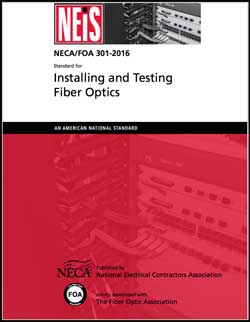
Download your free copy of ANSI/NECA/FOA-301
here (PDF)
Older
questions are now available here.
|
Training / FiberU
News and resources to help you learn more and stay
updated.
Find a
listing of all the FOA-Approved schools here.

Free online
self-study programs on many fiber optics and
cabling topics are available at Fiber U, FOA's
online web-based training website.
Free online training at
Fiber U
The FOA has >100
videos on  |
Why should a tech want to take certifications beyond the CFOT?
The CFOT was created to be the certification
for all fiber optic techs no matter what their job entails. The KSAs
(https://www.foa.org/KSAs.html) are intended to cover the basic
knowledge for a tech and prepares them to learn more on-the-job.
A few years later, we created CPCT, a certification for those involved
in premises cabling for LANs, security systems, etc. that included
copper wire, fiber and wireless as used in buildings.
FOA then created specialist skills certifications in Outside Plant
installation, Splicing, Testing and Connectors for those who want to
learn faster and more thoroughly than they would on the job and show
their expertise with a certification.
FOA also created a certification for Fiber Optic Network Designers,
something that is hard to learn on the job becasue of it’s complexity
and often the lack of a mentor to learn from.
Then there are applications specialties - fiber to the home, fiber for
wireless, fiber optic LANs, data centers, etc. where you can learn the
applications before trying to learn it on the job.
All the FOA certifications are created by subject matter experts and
kept up to date, Those subject matter experts help create the online
reference materials, textbooks and curriculum for teachers. FOr example,
the textbook and curriculum on fiber optic testing involved more than
40 subject matter experts from more than a dozen countries around the
world.
So with a CFOT, you have the basics and will learn on the job. Or you
can take a specialist certification and learn it beforehand and quickly.
And have a certification to show for it.
More information on FOA Certifications.
FOA School News
FOA's roster of approved schools is growing as more organizations
recognize our expertise in workforce development and our comprehensive
support for getting new schools started. FOA has over 25 years
experience and nearly 90,000 certified fiber techs (with ~120,000
certifications). As a non-profit organization founded by the industry
specifically to develop a competent workforce, FOA provides the
consultation, curriculum and contacts to get schools started as a free
service to new schools.
Complete listing of FOA Approved Training Organizations
Need A Fiber Optic Course Onsite? Invite an FOA School To Come To You
FOA often gets inquiries from an organization that
has personnel that needs training in fiber optics. Recent inquiries have
included contractors, a manufacturer of high-reliability products using
fiber optics and a cable manufacturer. In many cases, where there are
several people needing training, FOA can recommend a FOA Approved School
and Certified Instructor who will come to their location to teach a
class. The advantage is of course the savings in travel costs if
the class comes to you, but it also offers the opportunity to customize
the course to fit your needs, even use your equipment or work on your
components, so the training is more relevant to those taking the class.
Contact FOA to discuss the idea of a custom, on-site class to see if it will better meet your needs.
Fiber U
On-The-Job Training (OJT) Program
The
FOA Fiber U OJT program for novices combines online study at
Fiber U with OJT with mentoring by experienced
co-workers and their supervisor to help new employees
develop into FOA-certified technicians in only
one year.
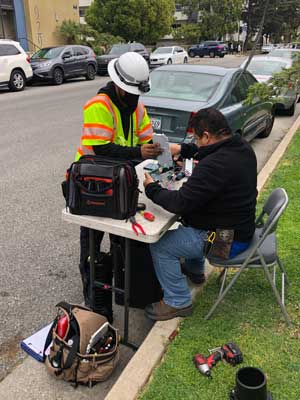
The FOA Fiber U “OJT-To-Cert”
program includes both fiber optics
and premises cabling (copper, fiber & wireless),
so it covers techs working in both outside plant and
premises jobs.
Like other FOA
programs, the OJT-To-Cert program is free. If you
and/or your company is interested in the FOA
OJT-To-Cert program,
contact FOA.
To explain how OJT
works and FOA's OJT-To-Cert program, FOA created a
short video: Lecture 62: On
The Job Training For Fiber Optics Using Fiber
U
FOA
Direct Certification Program For Experienced Fiber Optic Techs
Experience Plus
Online Study At Fiber U = FOA Certification
Experienced fiber optic technicians can become FOA Certified using
their experience in fiber optics and study for the
FOA certification exams online at Fiber U. Thousands of
industry professionals have applied to the FOA
directly for certification without the need for
classroom training, based on their knowledge and
skills developed working the field. Since FOA
certifications are based on KSAs (knowledge, skills
and abilities), current techs can show the
skills and abilities required through their field
experience. FOA provides free online self-study courses at Fiber U for the knowledge
part to prepare you for FOA certification exams
which you can also take online.
If you are an experienced field tech interested in
certification, and FOA is the internationally
recognized certifying body for fiber optics, you can
find out more about the FOA Direct Certification Program
here.
If you are already a CFOT, FOA also offers many
specialist certifications you can obtain based on
your experience as a field tech. See what's
available at Fiber
U.

Fiber U "Basic Fiber
Optics" Online Self-Study Course Now In Spanish
El curso de
autoaprendizaje en línea "Fibra óptica básica" de
Fiber U ahora en español
El sitio de
aprendizaje en línea de FOA, Fiber U, tiene más de
dos docenas de cursos de autoaprendizaje gratuitos
sobre fibra óptica y cableado de instalaciones.
Como era de esperar, el tema más popular es el
curso "Fibra óptica básica", que se utiliza para
iniciarse en la fibra óptica y como curso de
preparación para realizar el examen de
certificación FOA CFOT.
Ahora el curso básico
de fibra óptica está disponible en español,
utilizando el libro de texto FOA en español, la
sección de la Guía en línea en español y la
capacidad de YouTube para traducir subtítulos de
video al español. El curso funciona exactamente
como la versión en inglés con 10 lecciones, cada
una con cuestionarios y una opción para tomar un
examen de Certificado de finalización.
Para presentar el nuevo curso de
español Fiber U, el examen Certificate of
Completion es gratuito, así que dígaselo a sus
contactos.
Curso Básico de Fibra Óptica
de Fibra U en español.
New Fiber U Course: Fiber Characterization
FOA has added a new course at Fiber U on Fiber Characterization. Fiber
characterization is the process for testing long fiber cable plants for
its ability for carrying high speed communications. With so many
networks now operating at 100, 200, 400 or even 800 Gb/s, fiber
characterization is important, especially on older fiber optic cable
plants.The free Fiber U Fiber Characterization course is available in two forms, as a standalone Fiber U fiber Characterization Course with its own Fiber U Certificate of Completion and as a separate Lesson in the Fiber U Fiber Optic Testing course. This course is recommended for those studying for the FOA CFOS/FC Fiber Characterization certification.
Fiber U MiniCourses: Got An Hour Or Less?
Learn Something New About Fiber Optics.
FOA
has introduced a new type of Fiber U
course, the MiniCourse, a free online course you
could take in a short time, perhaps as you ate lunch
at your desk or took a coffee break. The
topics of these courses should explain what they are
about, and these are all very important topics to
fiber optic techs.
New Fiber U MiniCourse - Fiber Optic Jargon
There is a new MiniCourse at Fiber U - Fiber Optic Jargon.
Jargon is the most important thing you need to learn when you learn
about a new technology. This short Fiber U MiniCourse is intended to
introduce you to fiber optic jargon and make learning about fiber much
easier. It's aimed at novices but is a good refresher for even
experienced techs.
Fiber Optics In Communications
Fiber Optic Jargon
How Optical Fiber Works
Fiber Optic Network
Restoration
Fiber
Optic Connector Identification
Fiber U Color Codes
The Mysterious
dB of Fiber Optics
Fiber Optic Cable Bend Radius
Fiber Optic Link Loss And Power
Budgets
Fiber Optic Connector
Inspection And Cleaning
Fiber Optic Media Conversion
Fiber Optic Cable Midspan Access
Reading An OTDR Trace
Reference Cables For Testing
Fiber Optic Attenuators
The courses have two components, video lectures and
readings, that are complementary. As usual there is
a self-test to allow you to check your
comprehension. As with other Fiber U courses if you
desire, you can take a short test for a Fiber U
Certificate of Completion that costs
only $10.
All these free courses and many more
are available at Fiber U.
What Fiber Techs
Don't Know -
What We Learn From
FOA Certification Tests
As
FOA moves more testing over to our digital online
testing system at ClassMarker, we have access to
more data about our testing, including what
questions and topics on the tests are answered
incorrectly most often. Having this data gives us an
opportunity to evaluate the questions and how they
are stated, but more importantly it allow us to help
our instructors teach the subjects and us to change
our curriculum and online courses to emphasize these
particular topics. These are some of the topics that
we have noticed are answered incorrectly more often
in FOA and Fiber U tests.
Most of the questions missed are on testing.
1. OTDRs - particularly what information is in the
OTDR trace.
2. The difference between dB and dBm
3. Loss budgets - both the concepts and doing the
math
4. Insertion loss testing - single-ended or double
ended for testing patchcords or cable plants, how to
set 0dB references
5. Units of measure - fiber is measured in microns,
wavelengths in nanometers, etc.
At FOA, we're working to add Fiber
U MiniCourses on these topics and working with
our schools to emphasize these topics in their
classes.
If you are going to be taking a FOA certification
course or test in the near future, these topics
should be on your final exam study list.
What We Learn From Hands On Labs
We learn about students performance in hands-on labs
from the feedback of our instructors and our own
experiences too. One big problem is the use of hand
tools. Growing up today, you learn how to use
keyboards, mouses and touch screens, but decades
ago, you also learned how to use basic hand tools.
This is big enough of a problem that we're
considering adding some video lessons on basic hand
tools to prepare students for cable prep,
termination and splicing that require the use of
hand tools.
FOA Guide "Basics Of
Fiber Optics" Now Available Online in Portuguese
(6/2020)

FOA
has now translated the Basics of Fiber Optics
textbook in our Online Guide into Portuguese,
joining Spanish and French translations. For those
speaking Portuguese, we have the technical
information and for schools we also have curriculum
available.
Here is the FOA
Guide in Portuguese,
Spanish
and French
translations.
Time
To Learn - Online
Some
schools have been closed during the pandemic, so FOA
has been working with them to create new online
learning experiences that can in some cases lead to
certification online. FOA certifications are still
based on the KSAs - knowledge from the classroom,
skills from the labs and abilities judged by
instructors or proven by actual experience.
ZOOMing
Much of what we're doing benefits from the
capabilities of "Zoom." Others have created
videoconferencing apps, but none work so well,
especially with limited bandwidth. We've seen remote
labs that have an instructor showing students how to
use the tools they were sent then watching them
duplicate their actions. We have worked out methods
to use Zoom to proctor FOA's online certification
exams.
Blended
Learning
While most FOA schools have suspended in-person
training during this period, some are offering a
"blended learning" option. That means that
students sign up for a FOA certification course,
take the classroom sessions on Fiber U with the
assistance of a FOA certified instructor. Now
online instruction can include reviewing the
labs using the Fiber U Basic
Skills Labs, then when it's possible to attend
classes at the school, complete the hands-on
labs and take the FOA certification exam.
Online Remote Labs
Alternatively, some schools are experimenting
with "remote labs," where the students get
sent tool kits and components and labs are
conducted by videoconferencing. Before the
labs, the students may watch demos by their
instructor on videoconferencing and/or review
the relevant "virtual hands-on" lessons in the
Fiber U Fiber Optics Basic Skills Labs
so they will already know the steps in the
exercises. And Fiber U has
the new Fiber U
DIY Basic Skills Lab lesson
with directions on how to
purchase inexpensive tools
online and use them to learn
basic fiber optic skills. Videoconferencing
allows the instructor to remotely monitor
their work and provide help as needed. Contact
the FOA for more information.
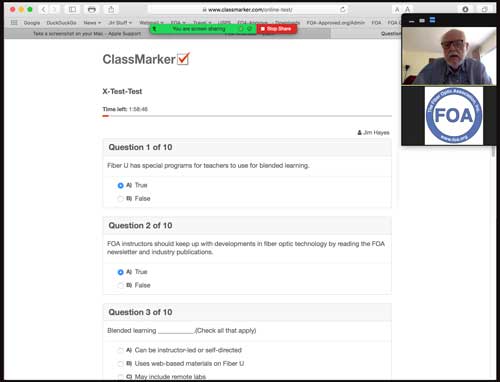
FOA Zoom Exam Proctoring
Online
Certification Testing
FOA has all its certification tests
available online, both for use by our
schools and by our direct "Work
to Cert" applicants. All FOA
certification tests require a proctor to
oversee the applicant taking the exam. In
this time of social distancing, getting a
proctor can be difficult, so FOA now has
procedures for online proctors
administering the exam. Contact
the FOA for more information.
OJT - On-The-Job-Training
Many novices get a job and learn on the job.
They usually have an experienced tech who helps
them gain the knowledge and learn the
skills they need to perform their job. Thinking
about this in relation to the FOA KSAs,
the knowledge, skills and abilities needed by a
fiber optic tech, the tech will learn
skills but not the basic knowledge that helps
them understand the processes involved. FOA can
offer help here with our FOA's
OJT-to-Cert Program,
using our Fiber
U online self-study programs. While the
tech learns on the job, they become a Fiber
U trainee, getting the knowledge they
need, while working under their "mentor" at
work. This is particularly good for
contracting companies who need techs but do
not have the usual training courses
available. Interested in OJT programs? Click
on the link below or contact FOA for
more information.
FOA's OJT-to-Cert
Program

FOA offers free online self-study programs at Fiber U.
Many users are preparing for FOA certification
programs - taking courses at our schools or using
the "Work-to-Cert" program. Some of our
schools are requiring Fiber U programs as
prerequisites for their classroom courses so they
can spend more time on hands-on activities.
FOA School Offers
Toolkit With Online Training
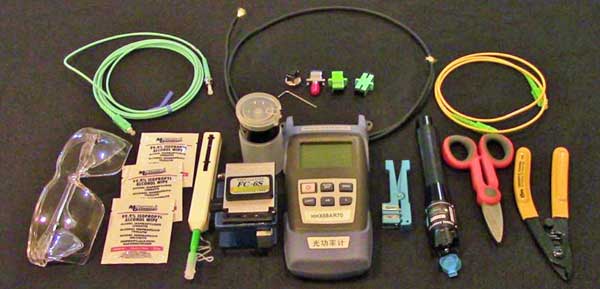
Slayton Solutions
(FOA Approved School #156) is offering a simple
fiber optic tool kit that includes a 29-piece set
of fiber optic tools and a power meter along with
training videos and online instruction for only
$499. 29 Piece Kit includes all tools and devices
a technician needs to install fiber optic
connectors and test optical power. You can contact them for
more information at slaytonsolutions@sbcglobal.net
or https://www.fiberopticsinstitute.com
|
Publications /
Resources

|
Cross Reference To FOA Tech Materials
FOA has so much technical reference material, we created a cross reference guide to the textbooks,
Online Guide and Fiber U courses, all the FOA technical information.
Besides the textbooks, online Guide and Fiber U, each section of the
Guide also includes links to the 100+ FOA videos available.
Cross Reference Guide to Textbooks, Online Guide and Fiber U
FOA Guide To Fiber Optic Workforce Development
To help those new to fiber optic workforce development, FOA has created a web page we call "Fiber Optic Workforce Development."
In this page, we share what we have learned about the fiber optic
workforce, who they are and how they learn their trade. We discuss what
defines a fiber optic tech and how they should be certified.
Read the FOA Guide To Fiber Optic Workforce Development online.
Latest FOA Book: Fiber Broadband (Paperback and Kindle)
 In less than half a century,
fiber optics has revolutionized communications and to a large extent,
society in general. Broadband, what many today call high speed Internet
access, has become a necessity for everyone, not a luxury. The
technology that makes broadband possible is fiber optics, connecting the
continents, cities, and just about everybody. Even fiber to the home
(FTTH) brings broadband to hundreds of millions worldwide. In less than half a century,
fiber optics has revolutionized communications and to a large extent,
society in general. Broadband, what many today call high speed Internet
access, has become a necessity for everyone, not a luxury. The
technology that makes broadband possible is fiber optics, connecting the
continents, cities, and just about everybody. Even fiber to the home
(FTTH) brings broadband to hundreds of millions worldwide.
How did we get from an era when communications was making a telephone
call or sending a telegram to today’s world where every piece of
information – and misinformation – is available at the click of a mouse
or touch on a screen? How did we get from a time when a phone was
connected on copper wires to being able to connect practically anywhere
on a handheld device with more computing power than was available to
scientists and engineers only decades ago?
How does broadband work? Without fiber optics it would not work.
This book is not the typical FOA technical textbook - it is written for
anyone who wants to understand fiber broadband or fiber optics or the
Internet. It's also aimed at STEM teachers who want to include
communications technology in their classes. This book will try to
explain not only how fiber broadband works, but how
it was developed. It is intended to be an introduction to
communications technology
appropriate for a communications course at almost any level (junior
high, high school or
college,) for managers involved with broadband projects, or for anyone
who just wonders how all this stuff works.
The Fiber Optic Association Guide To Fiber Broadband
Paperback ($12.95) and Kindle ($9.95) versions available from Amazon or most booksellers. Kindle version is in color!
More Translations of FOA Textbooks
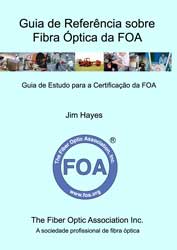 FOA is a very international organization and it works hard to
accommodate the language needs of everyone. We have been translating our
books and website into the languages most requested, and this month, we
add two more textbook translations. We also want to thank Jerry Morla,
FOA CFOS/I instructor and Director who has been doing the recent
translations into Spanish, his native language. FOA is a very international organization and it works hard to
accommodate the language needs of everyone. We have been translating our
books and website into the languages most requested, and this month, we
add two more textbook translations. We also want to thank Jerry Morla,
FOA CFOS/I instructor and Director who has been doing the recent
translations into Spanish, his native language.
Here is a listing of all the FOA textbook Translations
Spanish Editions:
Guía de Referencia de la Asociación de Fibra Óptica (FOA) Sobre Fibra
Óptica: Guía de estudio para la certificación de la FOA Amazon
La Referencia de Cableado para Predios de la FOA: Guía para Certificación de la FOA Amazon
La Asociación de Fibra Óptica Manual de Fibra Hasta el Hogar : Para
Planificadores, Gestores, Diseñadores, Instaladores y Operadores De
FTTH Amazon
Guía de Referencia de la FOA sobre Diseño de la red de fibra óptica: Guía de Estudio para la Certificación de la FOA Amazon
And the FOA Reference Guide To Fiber Optics:
French Edition: Le
Guide de référence de la FOA pour la fibre optique et et
guide d'étude pour la certification FOA: Guide d'étude pour
la certification FOA Amazon
Portuguese Edition: Guia de Referência sobre Fibra Óptica da FOA : Guia de Estudo para a Certificação da FOA Amazon
The subject matter of these books is also translated in the FOA Guide online.
Planning A Fiber Optic Project?
The FOA Guide To Fiber Optic Projects includes this timeline and comments on project planning and implementation.
More New FOA Video
Lectures On YouTube
Did you know YouTube
will close caption videos in many languages?
Here are directions.
FOA Lecture 73, The History of Fiber Optics - A Timeline fiber optics from the beginning.
FOA YouTube Video Describes
On-The-Job Training (OJT)
FOA Lecture 67 Fiber Optics At
Electrical Utilities
More New Videos
Including FTTH Series
Like all our YouTube lectures, they are
all short and easy to understand.
Did
you know YouTube will close caption videos in many
languages?
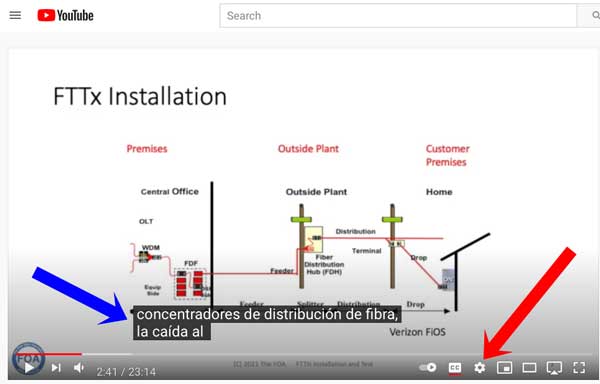
Sign in with Google to get translations for closed
captioning. Click on the settings icon (red arrow.)
Choose "Subtitles". English is the default
language. Click on the arrow after "English
(auto-generated) >". In the new window click on
"Auto-translate" and choose the language you
want.
FOA Loss Budget
Calculator On A Web Page 5/2020
FOA
has written many articles about loss budgets,
something everyone involved in fiber optics needs to
know and needs to know how to calculate. We recently
discovered how to get a spreadsheet ported to a Web
page, so we created this web page that calculates
loss budgets. We have an iOS loss budget app, but
with this web page, you can calculate loss budgets
from any device, smart phone, tablet, laptop, or
desktop computer that has web browsing capability.

Bookmark this page (especially on your
smartphone): FOA Loss Budget Calculator
Online
 We are continually updating the Online Reference
Guide to keep up with changes in the industry and
adding lots of new pages of technical information.
When you go to the FOA
Guide Table of Contents to see the latest
updates - look for
We are continually updating the Online Reference
Guide to keep up with changes in the industry and
adding lots of new pages of technical information.
When you go to the FOA
Guide Table of Contents to see the latest
updates - look for  . .
Recent updates:
FTTH
Updates: Added a section on FTTH Network Design,
updated Architecture and PONs (10G)
Color Codes For Fiber Optics
Includes print your own pocket guide and versions for your smartphone.
Fiber
Optic Projects - the FOA Guide to projects from
concept to operation
Coherent Communications Systems in
the FOA Guide.
Go
to The FOA Online Fiber Optic
Reference Guide.
FOA Reference Books
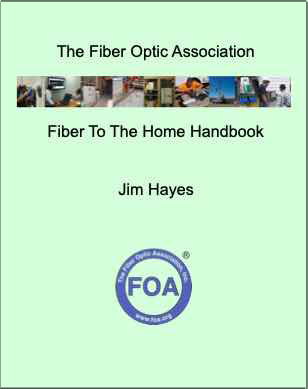
FOA's FTTH Handbook: We've
gathered all our information on FTTH from the FOA
Guide and past issues of the FOA Newsletter and
edited it into a 112 page "FTTH Handbook." We even
added a section on planning and managing FTTH
Projects.
The Fiber Optic Association
Fiber To The Home Handbook is
available from Amazon in print and Kindle
editions.
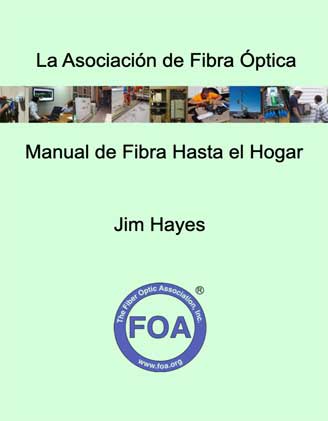
Sitio web y manual de FTTH ahora en español
Sitio web y manual de FTTH ahora en español - FTTH Website And Handbook Now In Spanish
El Manual FOA FTTH se ha convertido en el libro FOA
más vendido y tiene una calificación de 4.7/5 por parte de los
compradores en Amazon.
FOA ha notado mucho interés en FTTH en otras áreas del mundo,
especialmente en América Central y del Sur, por lo que tradujimos el
sitio web de FTTH y el Manual de FTTH al español.
Available in paperback from Amazon or ebook on Amazon Kindle.
Disponible como libro de tapa blanda en Amazon o como libro electrónico en Amazon Kindle.
El sitio web de FOA FTTH ahora en español.
El Manual FOA FTTH se ha convertido en el libro FOA
más vendido y tiene una calificación de 4.7/5 por parte de los
compradores en Amazon.
FOA ha notado mucho interés en FTTH en otras áreas del mundo,
especialmente en América Central y del Sur, por lo que tradujimos el
sitio web de FTTH y el Manual de FTTH al español.
Disponible como libro de tapa blanda en Amazon o como libro electrónico en Amazon Kindle.
El sitio web de FOA FTTH ahora en español.
 
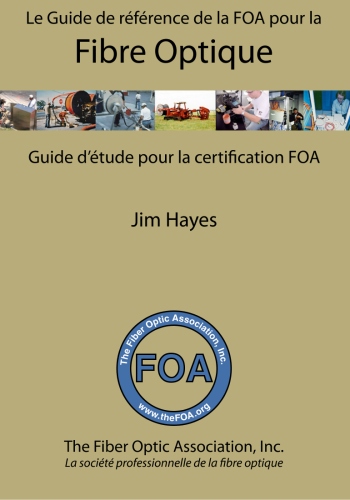      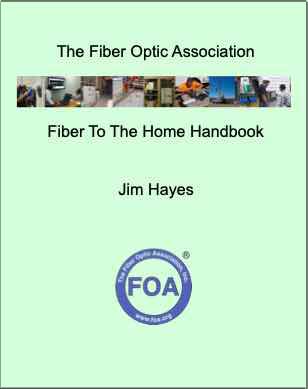
Fiber Optics (4 languages), Premises Cabling, OSP
fiber and construction, Network Design, Testing and
FTTH
The FOA has it's own
reference books for everyone working in fiber
optics - contractors, installers and end users as
well as for use as textbooks in classes at
educational institutions. They are available as
printed books or Kindle at much lower prices than
most textbooks since we self-publish and sell
online, cutting out the middlemen. Click on the
book images for more information. The Reference
Guide To Fiber Optics is also available in
Spanish, French and Portuguese. The Design book is available in English
and Spanish.
Click on any book for more information
about it.
FOA
has reprinted

"Lennie Lightwave's Guide"
on its 25th anniversary in a special print
edition.
Lennie
and Uncle Ted's
Guides are online or as free iBooks on iTunes.


Click on any of
the books to learn more.
- Fiber
Optic Safety Poster to download and
print
Resources For
Teachers In K-12 And Technical Schools
Teachers in all grades can introduce their
students to fiber optic technology with some
simple demonstrations. FOA has created a page for
STEM or STEAM (science, technology, engineering, arts
and math) teachers with materials appropriate to
their classes. Fiber Optic Resources For
Teachers.
|
Safety
|
On Safety
The FOA is concerned about safety!
FOA
considers safety an integral part of all our
programs, curriculum materials and technical
materials. We start all our textbooks and their
online versions with a section on safety in the
first chapter, like this: Before
we get started - Safety First!
There are pages on the FOA Guide on Safety
procedures Including Eye Safety and. Digging
Safely
And a YouTube lecture: FOA Lecture 2: Safety When Working
With Fiber Optics
In our OSP Construction Section, these pages cover
many safety issues including those related to the
construction of the cable plant: Project Preparation And Guidelines,
Underground Cable Construction,
Underground Cable Installation
and Aerial Cable Installation.
There is even a safety poster for the fiber
activities: PDF Safety Rules For Fiber Optics
Other Safety Resources:
There is a toll-free
"call before you dig" number in the USA: Dial 811. See www.call811.com
for more information in the US. Here is their map of resources by states.
In Canada, it's "Click Before You Dig.com" They also have a page of resources by US states and Canadian provinces.
The Common Ground
Alliance has an excellent "Best Practices Guide"
online
- The US Department
of Transportation has a website called "National
Pipeline Mapping System" that allows one
to search for buried pipelines.
Why We Warn You To
Be Careful About Fiber Shards
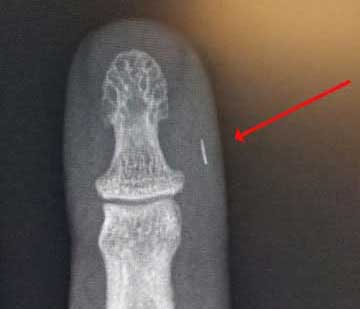
Photo courtesy Brian Brandstetter,
Mississauga Training Consultantcy
2023 Conference On
Damage Prevention In Tampa

Global Excavation Safety Conference Tampa, Florida
February 14-16, 2023
GlobalExcavationSafetyConference.com:

The magazine, dp-Pro, sponsor of the conference,
has also published it's latest issue with an
article by FOA on "New Construction Techniques
in Fiber Optics" and a overview of the FOA. You can read the magazine here.
When You Bury Marker
Tape, Bury One That Will Work (July 2021)
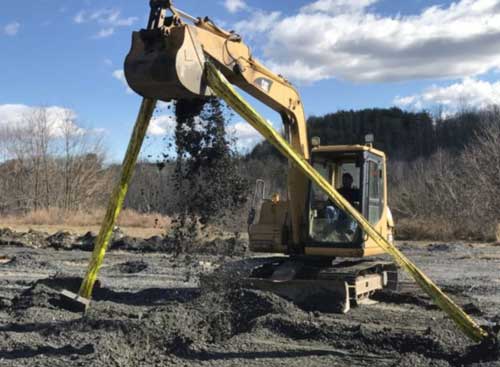
Signaltape® provides a visual
warning by ensuring tape is brought to the surface,
alerting the operator to the presence of a buried
utility. It includes a 3,000-lb. tensile strength
aramid fiber membrane, which ensures the tape is
pulled to the surface to alert the excavation crew.
Signaltape
comes in two sizes: 12″ x 1000′ or 6″ x
1000′.
FOA
Corporate Program - Products & Services
Search
for products and services offered by hundreds of fiber optic companies worldwide.
List
of corporate information on the FOA website.
FOA Corporate Program is available to companies involved in fiber
optics as manufacturers, contractors, installers, etc. Read
more.
|
FOA/About
About The FOA
- Contact
Us: http://www.foa.org
or email <info@foa.org>

FOA has a company page
and four LinkedIn Groups
FOA
- official company page on LinkedIn
FOA
- covers FOA, technology and jobs in the fiber optic
marketplace
FOA
Fiber Optic Training - open to all, covers
fiber optic technology and training topics
Grupo de La Asociación de
Fibra Óptica FOA (Español)
|
What is The FOA?
The FOA is a, international non-profit
educational association chartered to promote
professionalism in fiber optics through education,
certification and standards.
Founded in 1995 by a dozen prominent fiber optics
trainers and leaders from education, industry and government as a professional society for fiber
optics and a source of independent certification,
the FOA has grown to now being involved in numerous
activities to educate the world about fiber optics
and certify the workers who design, build and
operate the world's fiber optic networks.
Read More
FOA History
FOA Timeline of Fiber Optics
Contact
Us
The Fiber Optic Association Inc.
https://www.foa.org or email
<info@foa.org>
https://www.thefoa.org or email <info@thefoa.org>
Telephone/text: 760-451-3655
The
FOA Home Page

Want to know more about fiber optics? Study
for FOA certifications? Free
Self-Study Programs are on "Fiber U®."
Looking for specific information? Here's the largest
technical reference on the web: The
FOA Online Fiber Optic Reference Guide.

Free online self-study programs
on many fiber optics and cabling topics are
available at Fiber U,
FOA's online web-based training website.
|
-
Contact Us
The Fiber Optic Association Inc.
The FOA Home Page
Fiber Optic Timeline
(C)1999-2023, The Fiber Optic Association, Inc.
|
FOA Logo
Merchandise
New FOA Swag! Shirts,
Caps, Stickers, Cups, etc.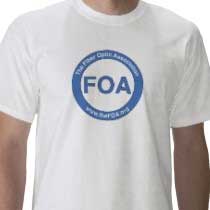
The
FOA has created a store on Zazzle.com offering lots
of new logo merchandise. It has lots of versions of
shirts and other merchandise with "FOA," "Fiber U,"
"Lennie Lightwave" designs and more so you should
find something just for you! See FOA on Zazzle.
-
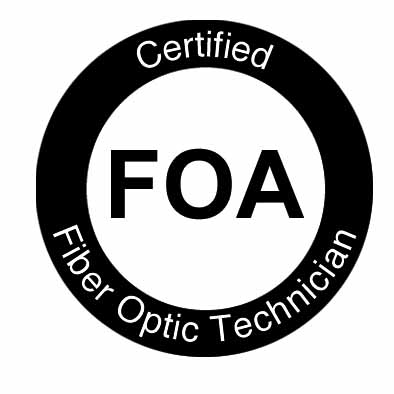
Your
Name, CFOT® - It pays to advertise!
The FOA encourages
CFOTs to use the logo on their business cards,
letterhead, truck or van, etc. and provides logo
files for that purpose. But we are also asked
about how to use the CFOT or CFOS certifications.
Easy, you can refer to yourself as "Your Name,
CFOT" or "Your Name, CFOS/T" for example.
Feel free to use the
logo and designations to promote your achievements
and professionalism!
Contact
FOA at info@thefoa.org to get logos in file format
for your use.
Privacy Policy (for
the EU GDPR): The FOA does not
use cookies or any other web tricks to gather
information on visitors to our website, nor do
we allow commercial advertising. Our website
hosts may gather traffic statistics for the
visitors to our website and our online testing
service, ClassMarker, maintains statistics of
test results. We do not release or misuse any
information on any of our members except we will
confirm FOA certifications and Fiber U
certificates of completion when requested by
appropriate persons such as employers or
personnel services.
Read
the complete FOA Privacy Policy here.
|
























































 OptConn
is a value-add re-seller of optical connectivity products, services and
solutions. With over 30 years of experience in the fiber optics
industry we are here to serve your requirements from fiber optic
training with FOA certification to products, materials and supplies.
OptConn
is a value-add re-seller of optical connectivity products, services and
solutions. With over 30 years of experience in the fiber optics
industry we are here to serve your requirements from fiber optic
training with FOA certification to products, materials and supplies. 





























 .
.








